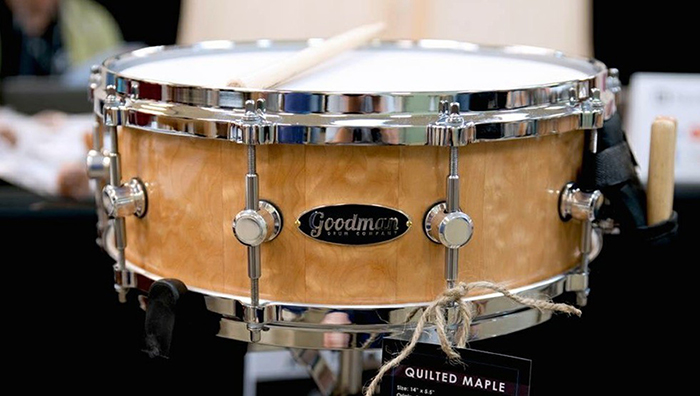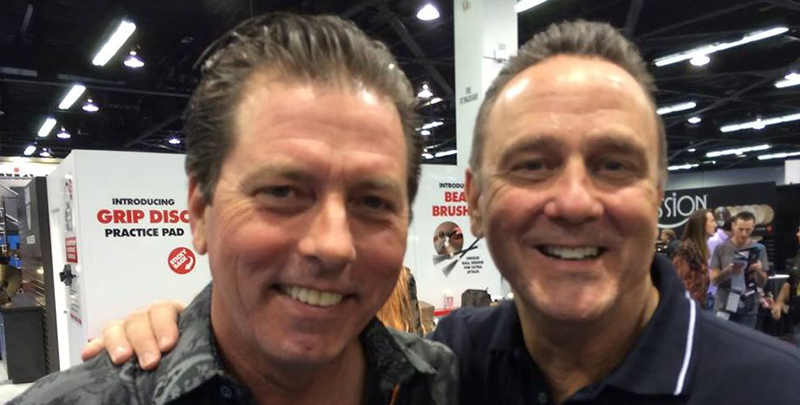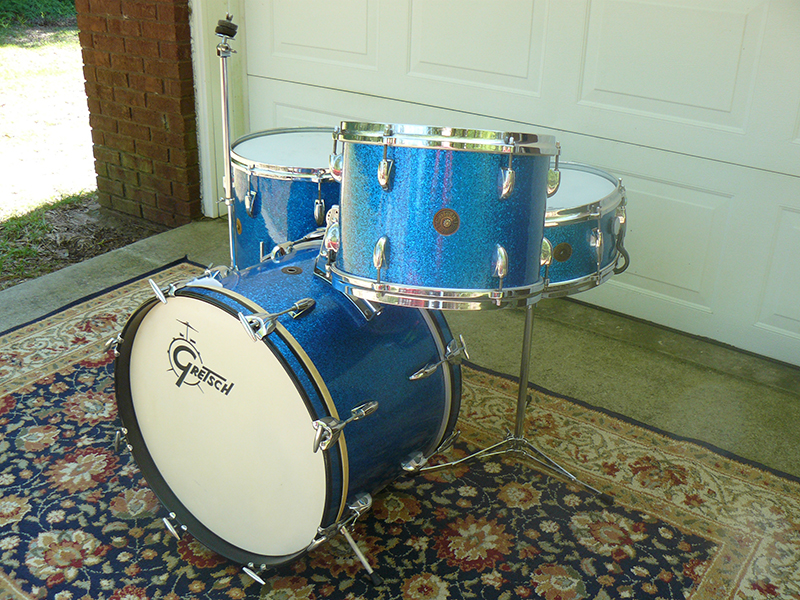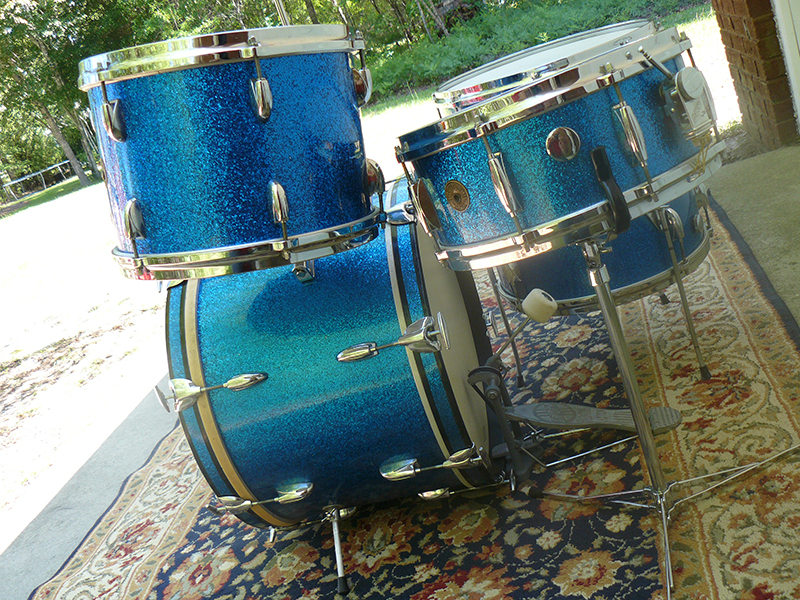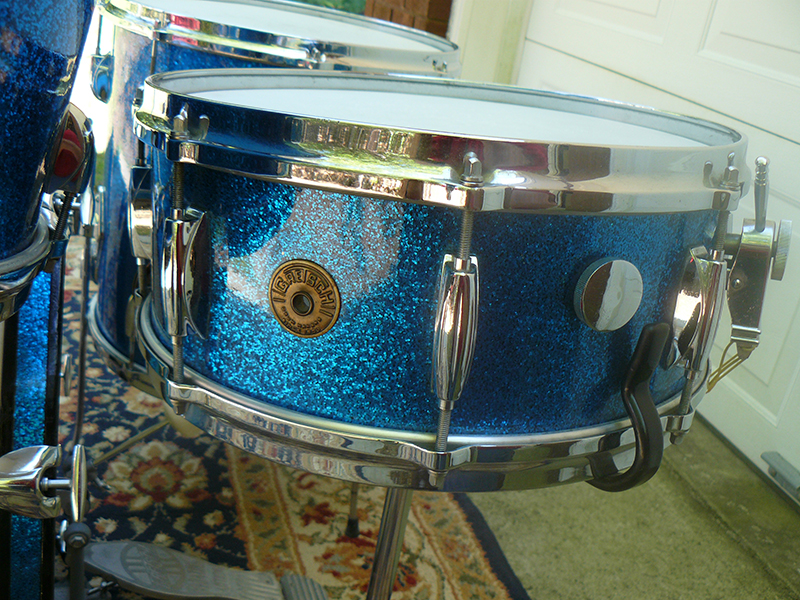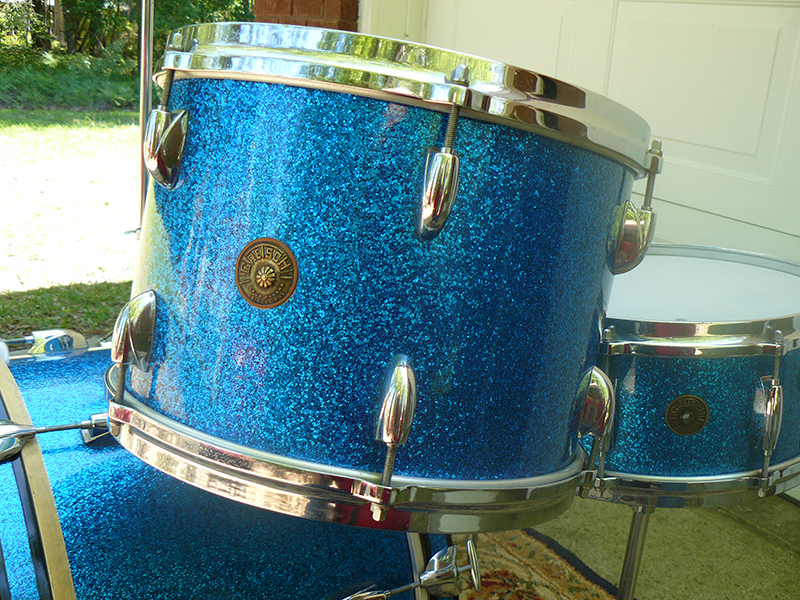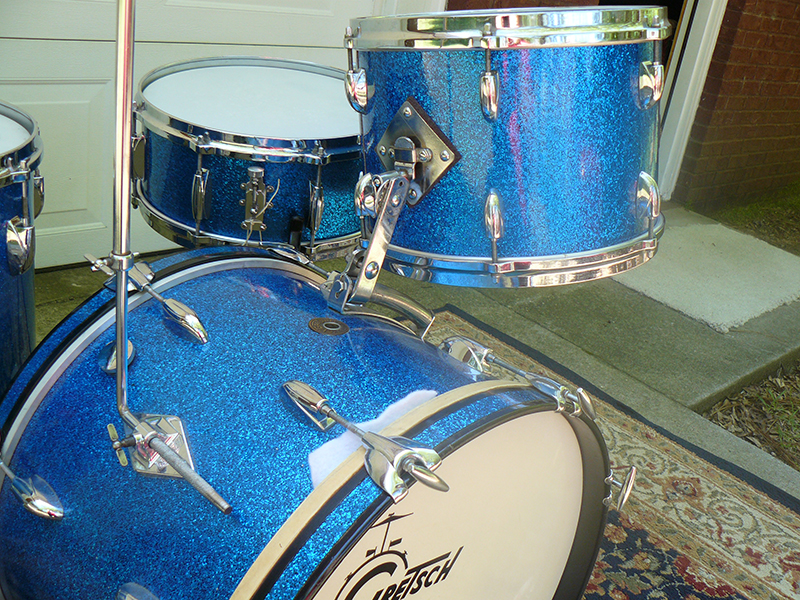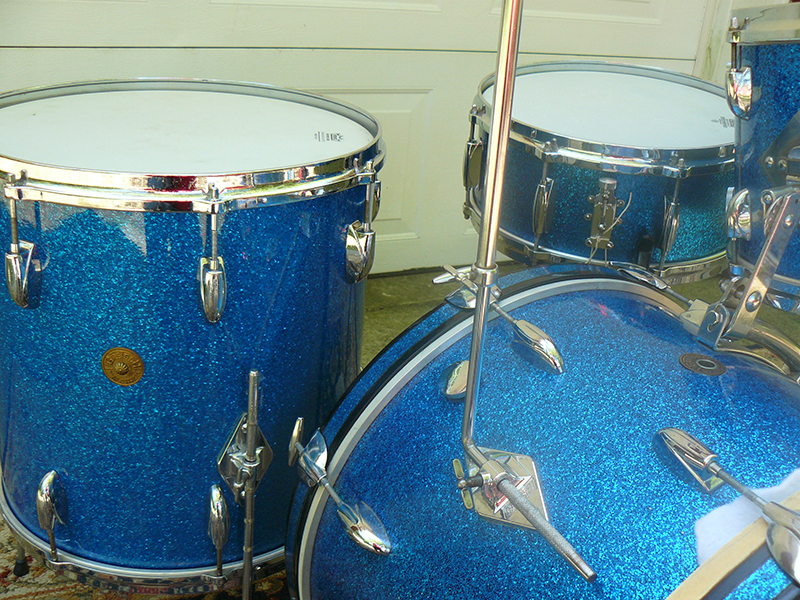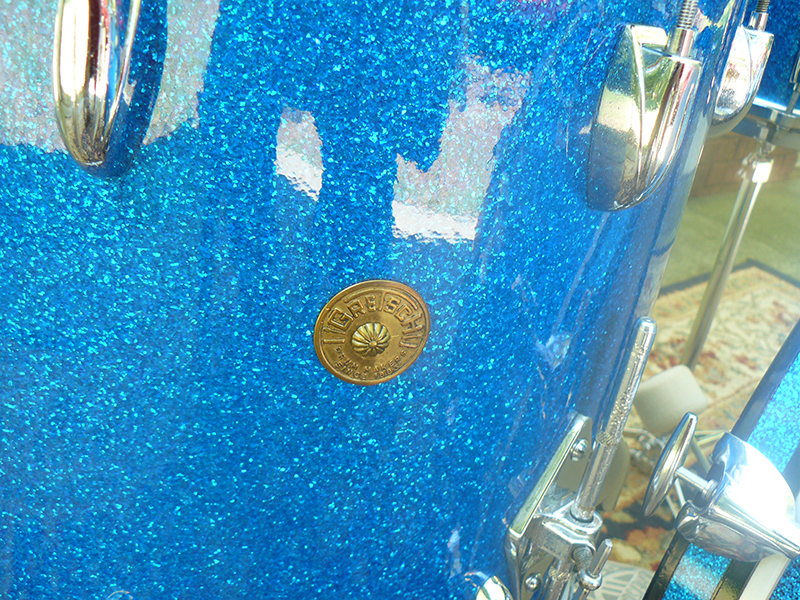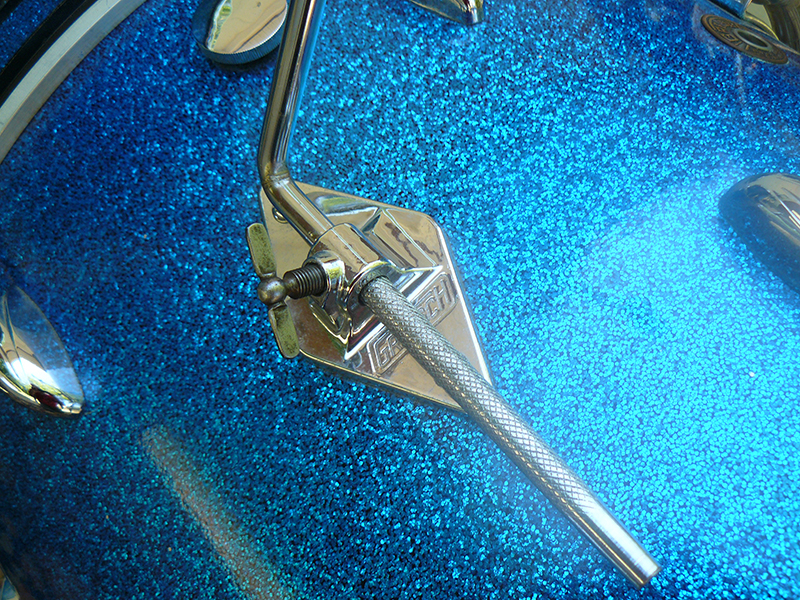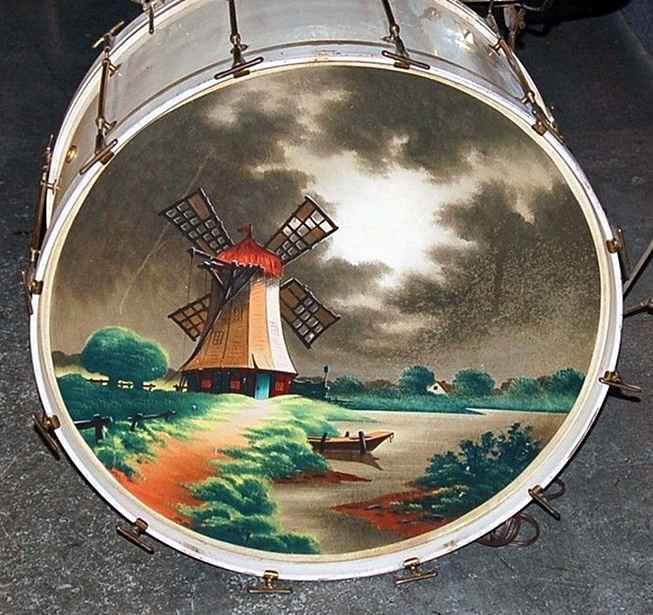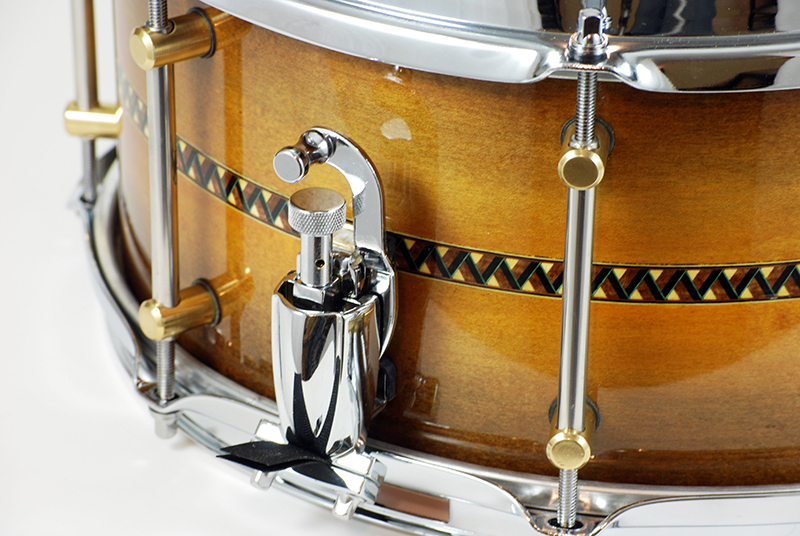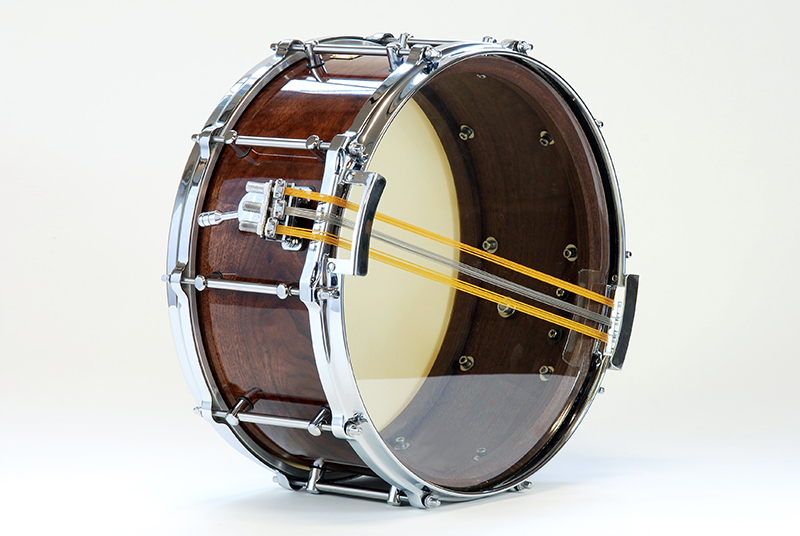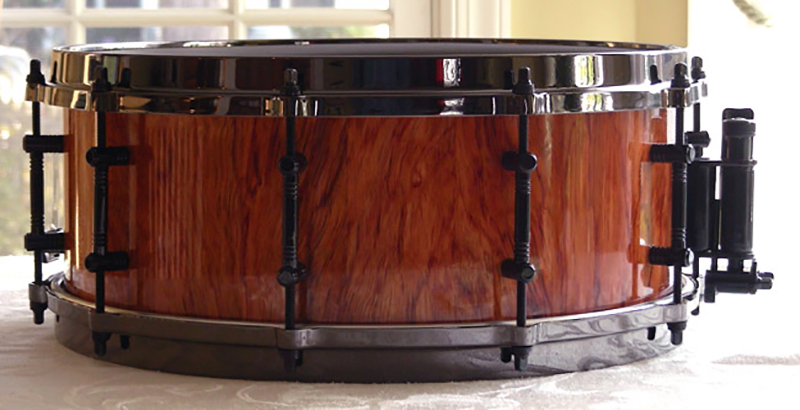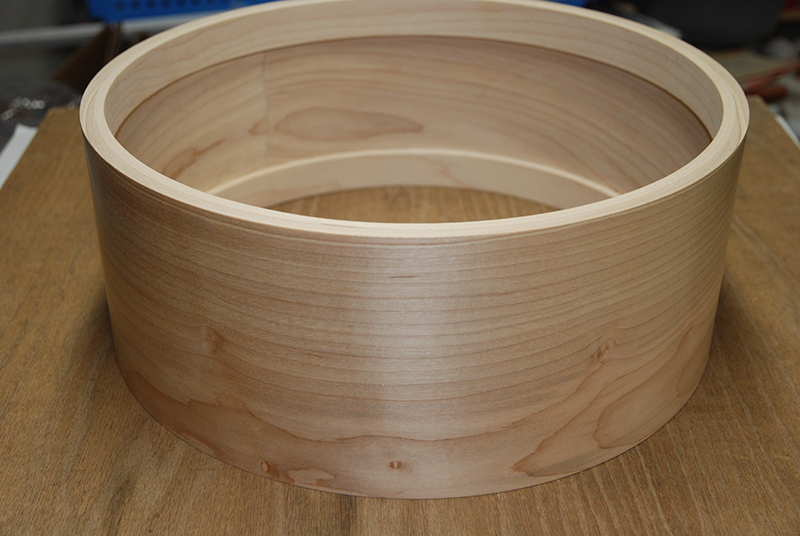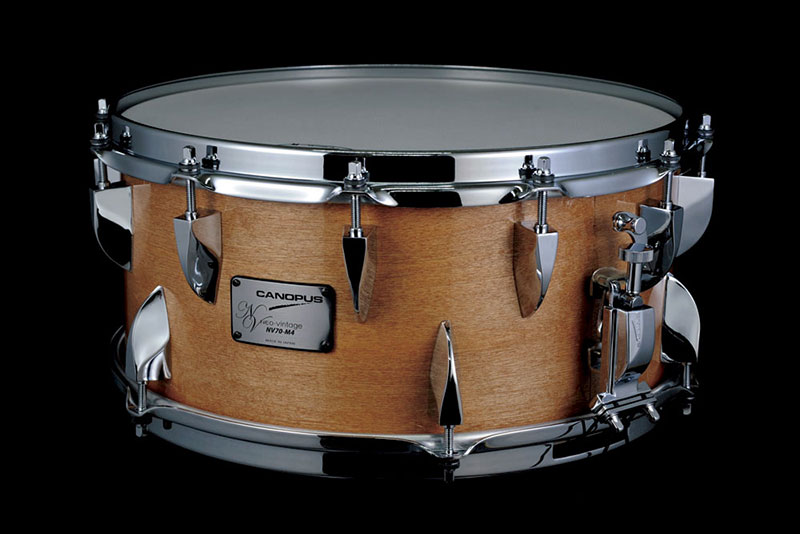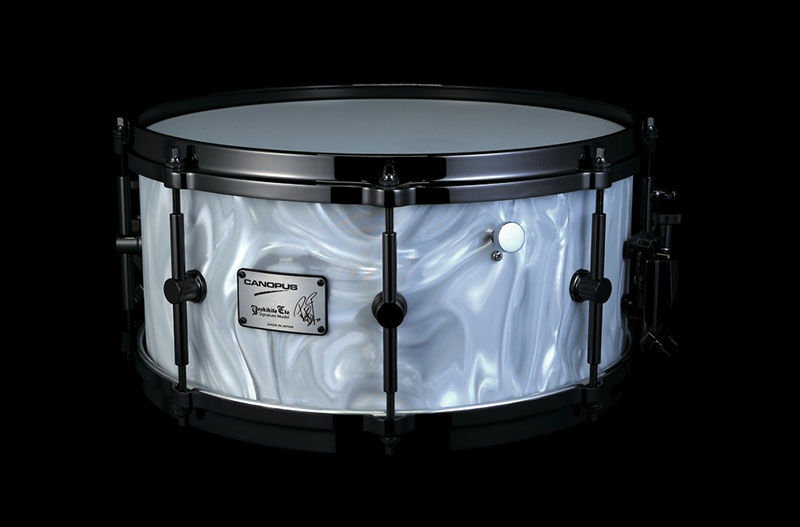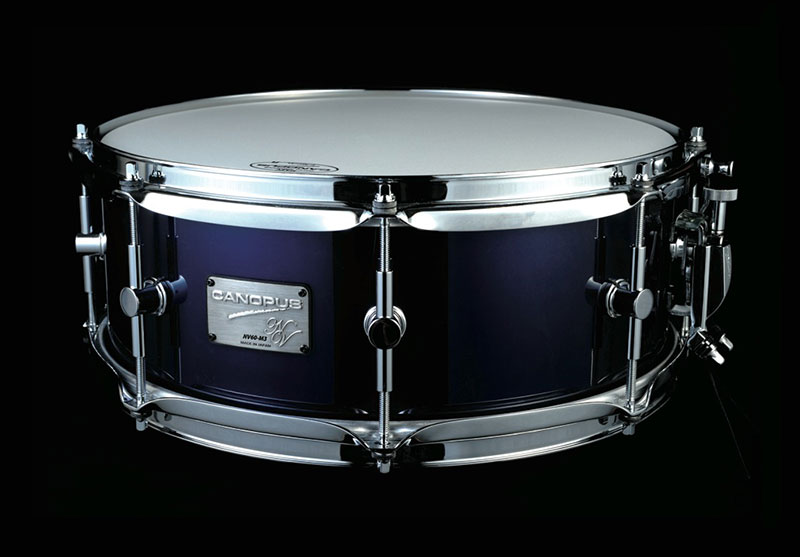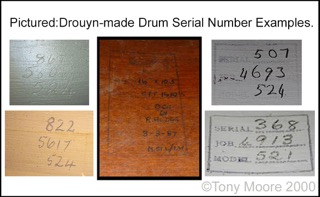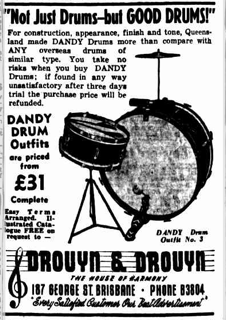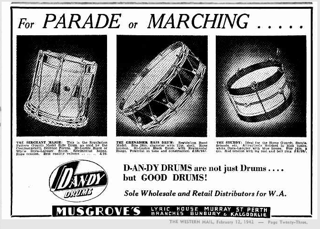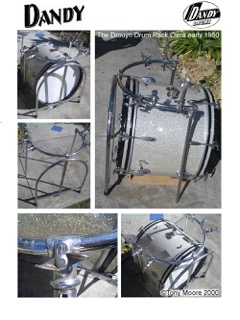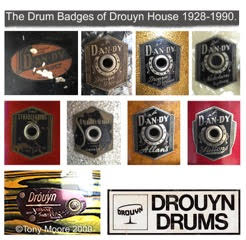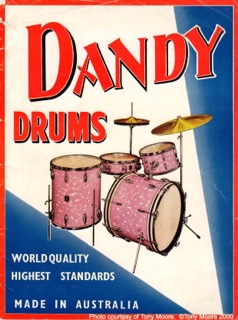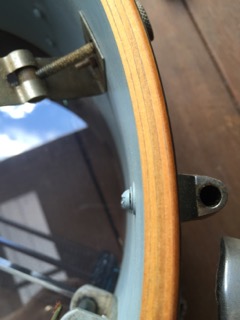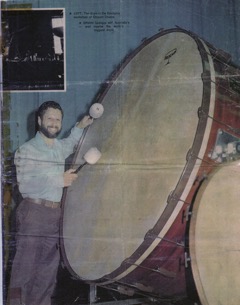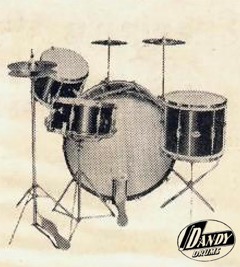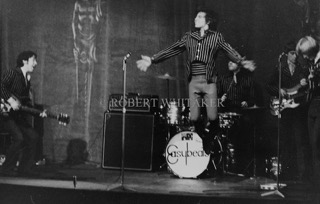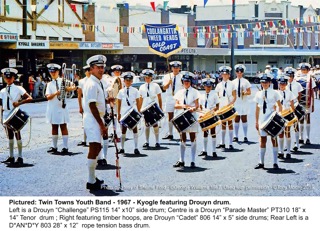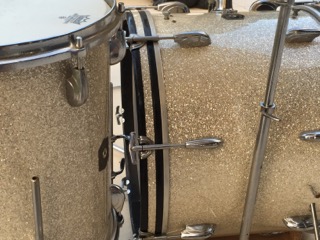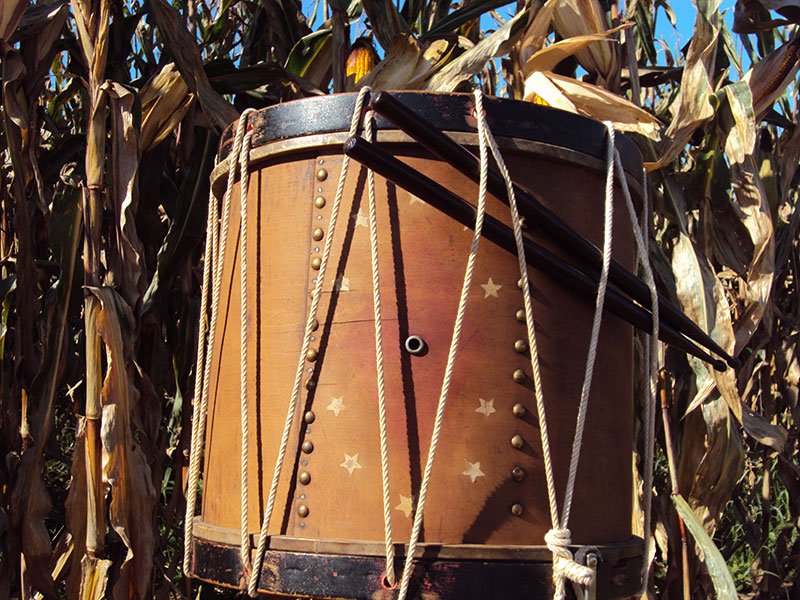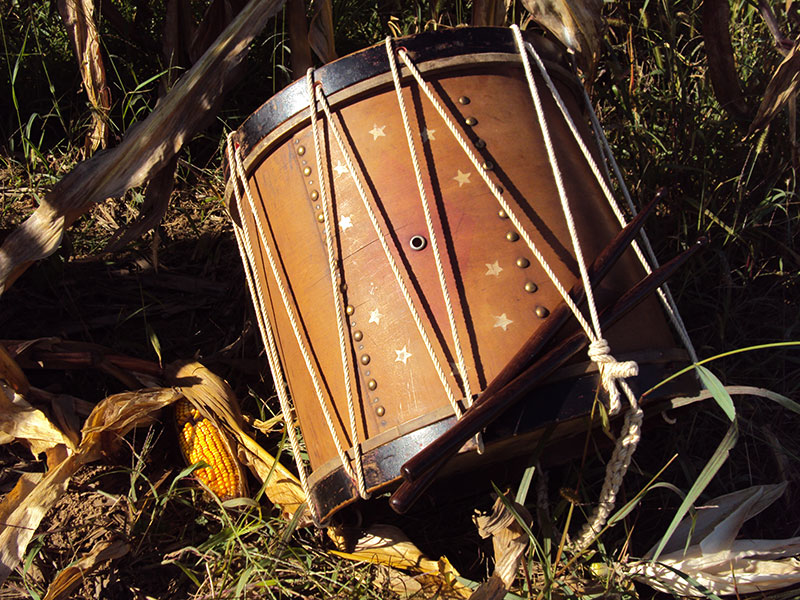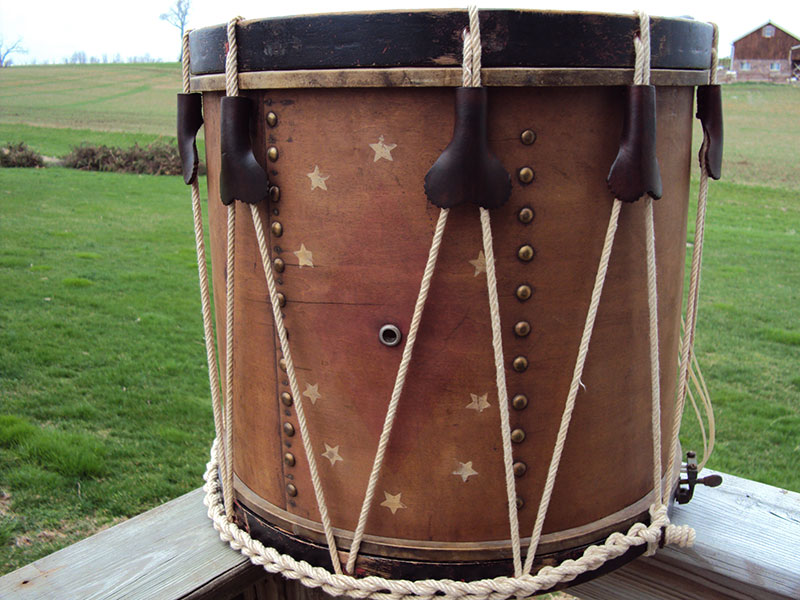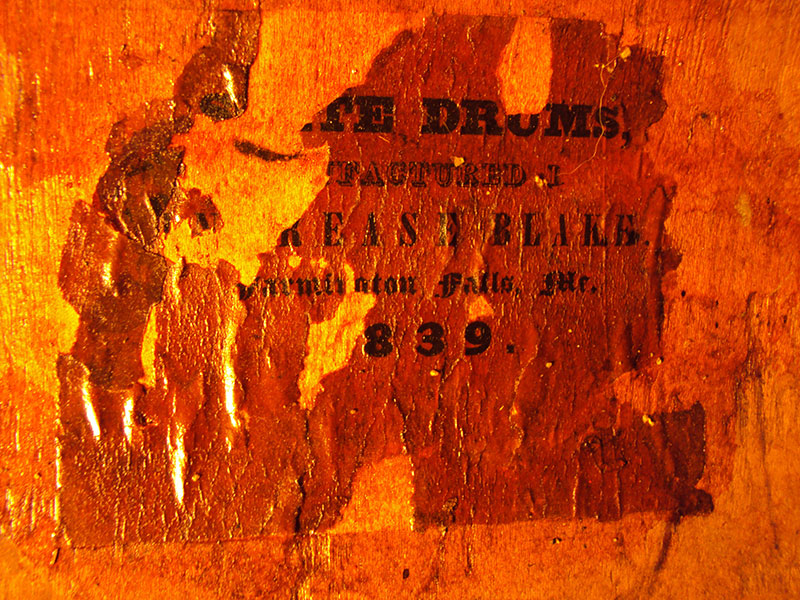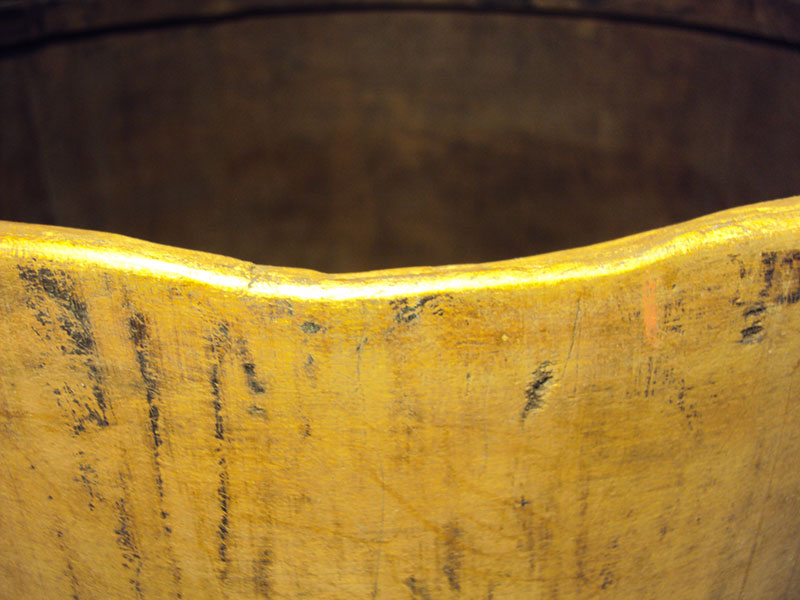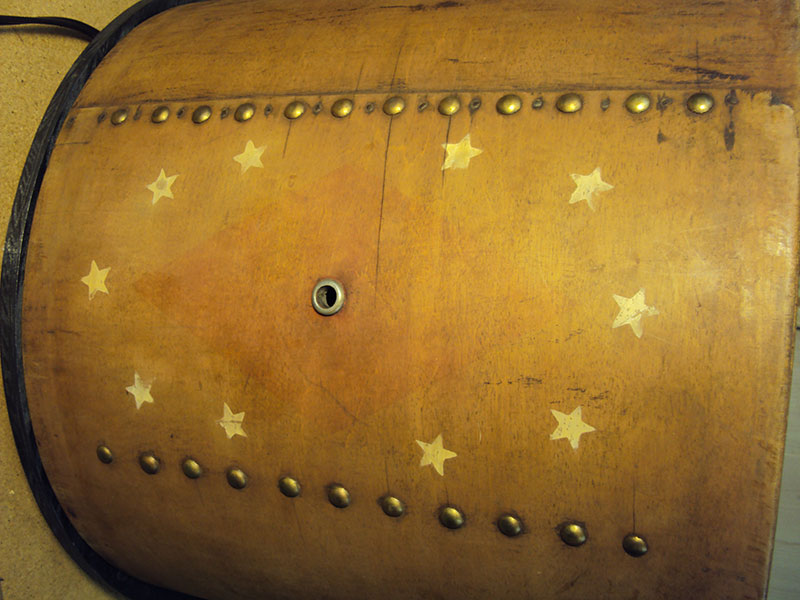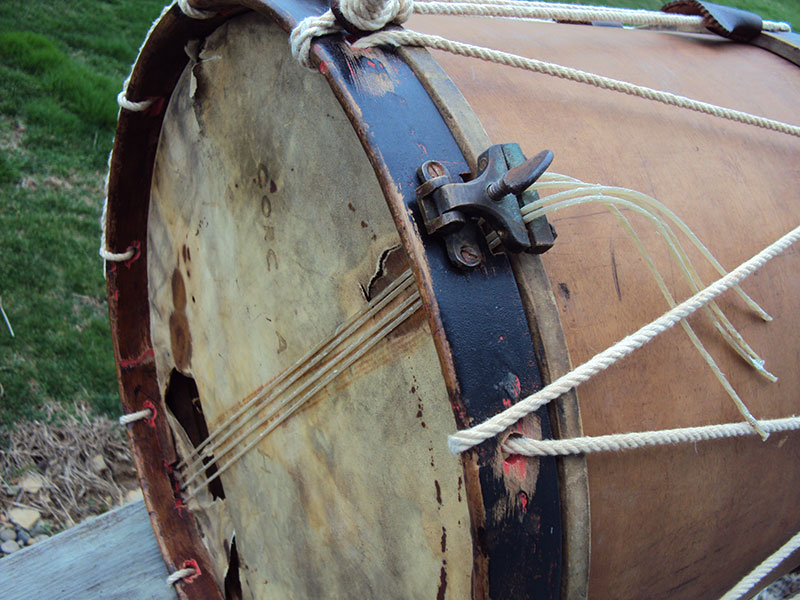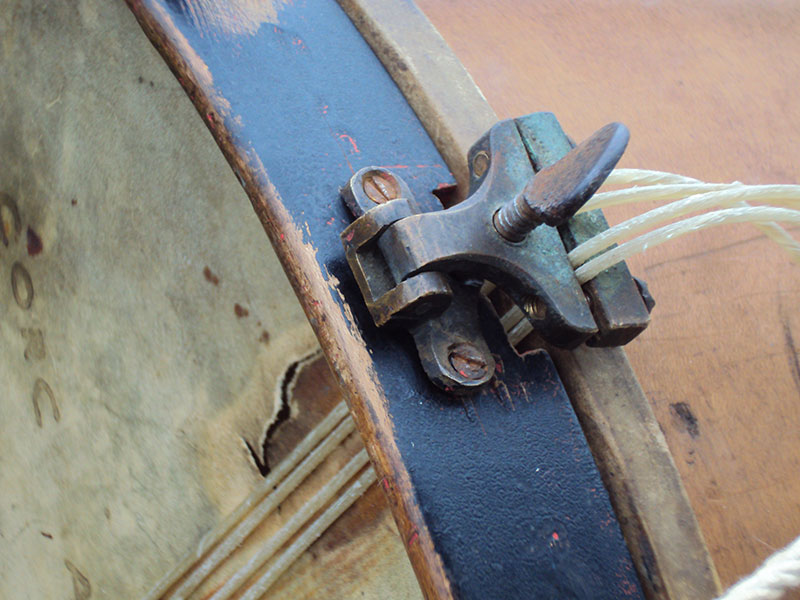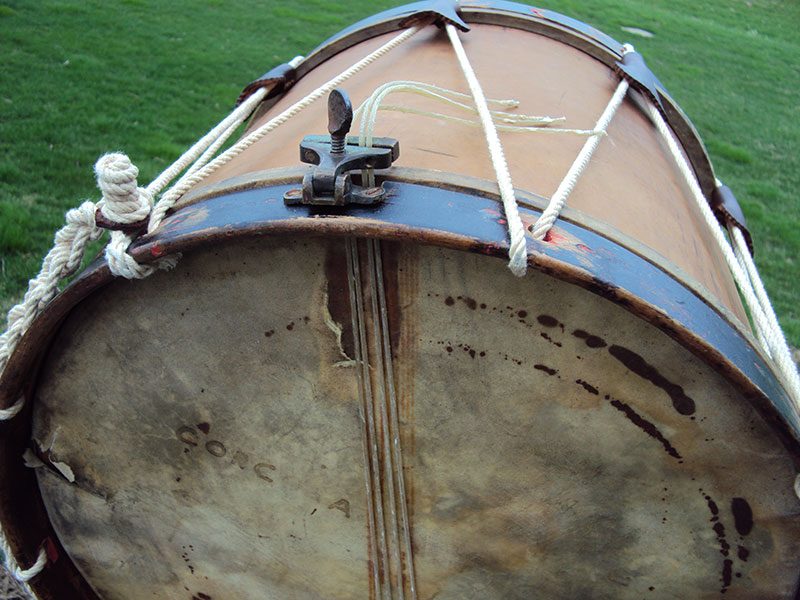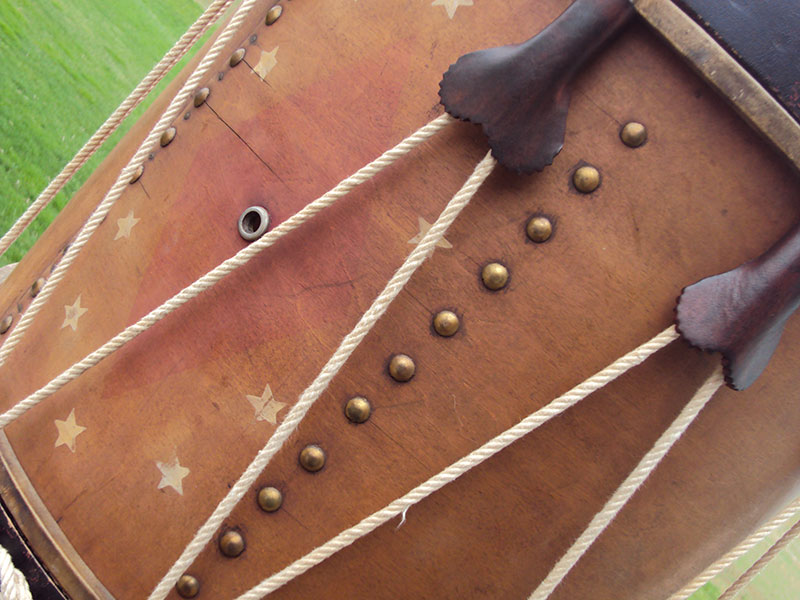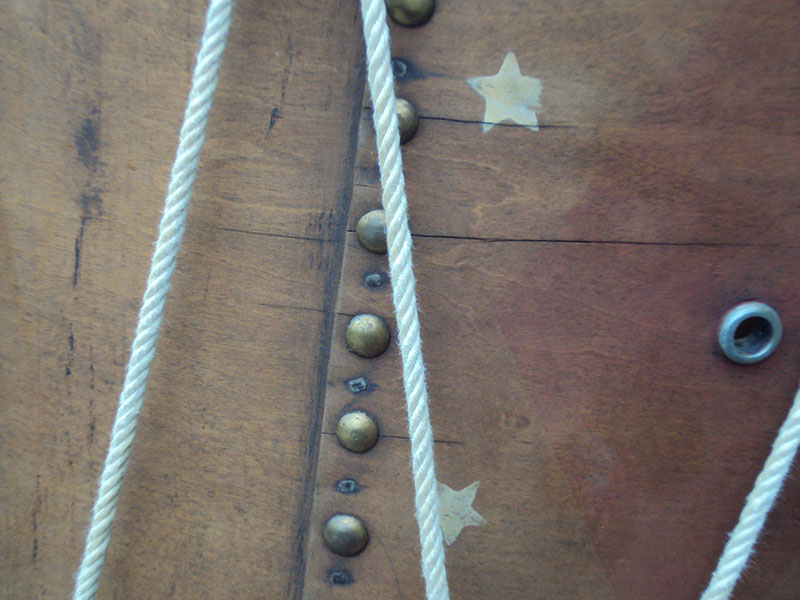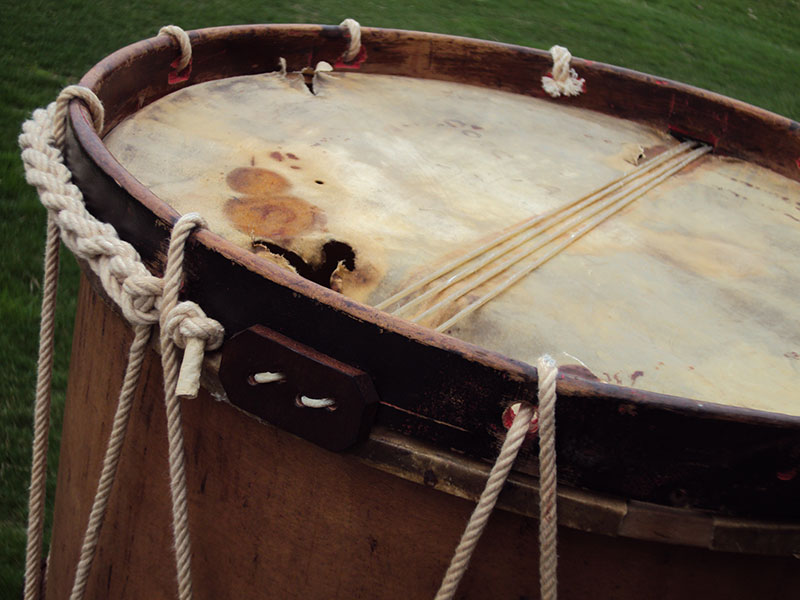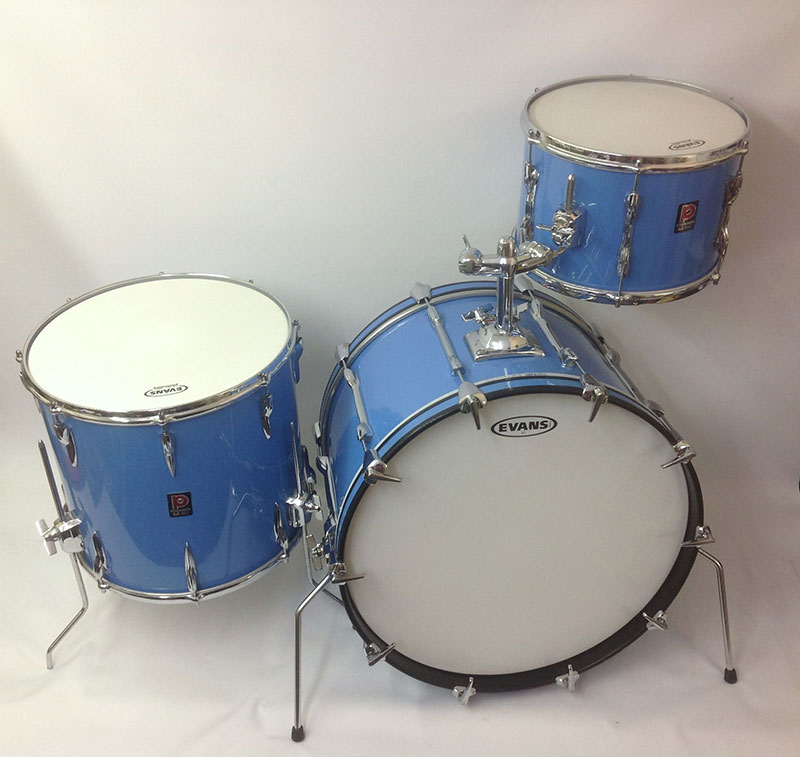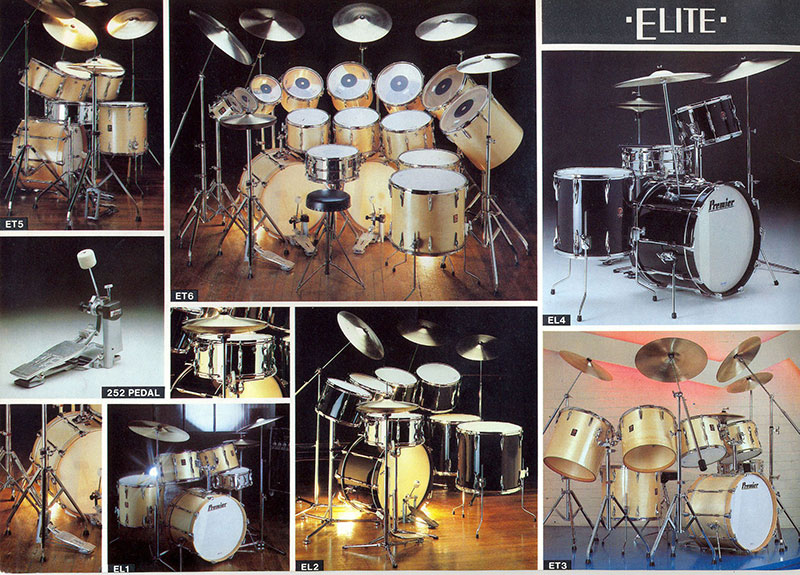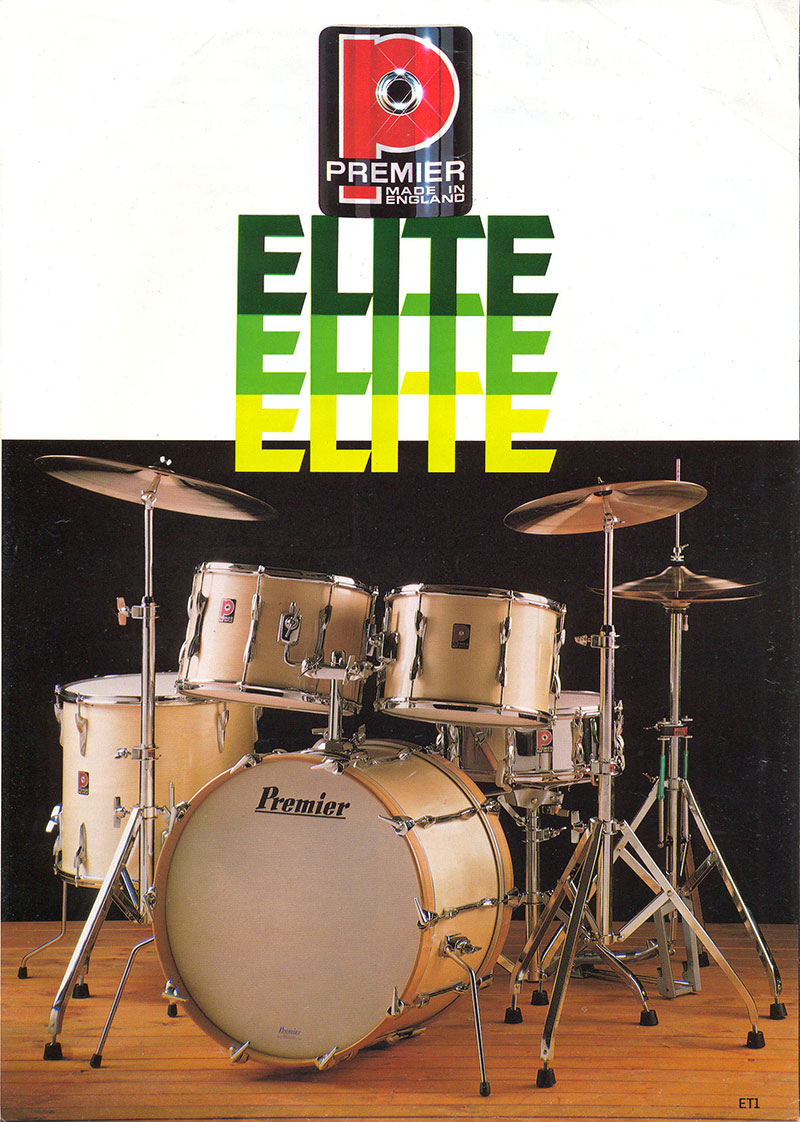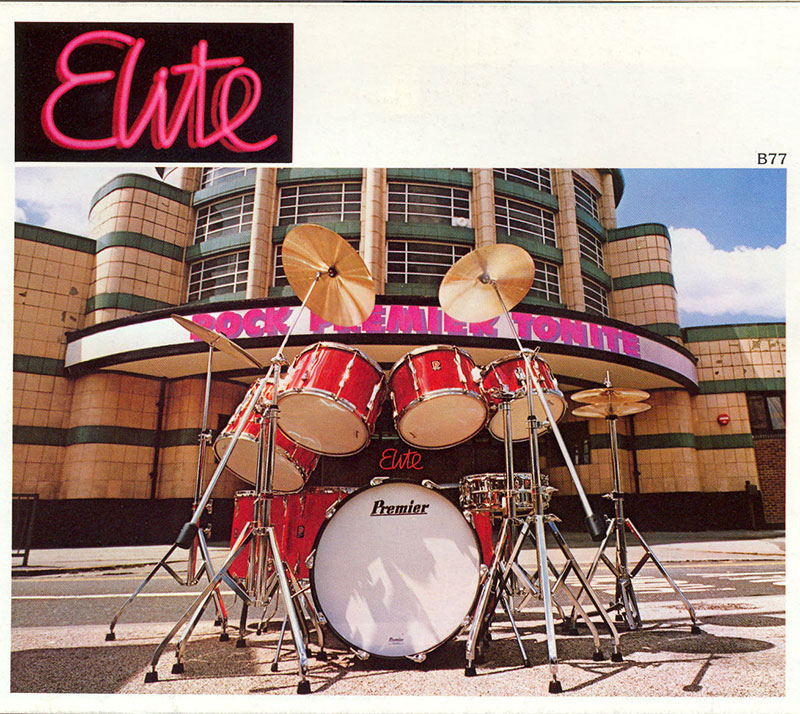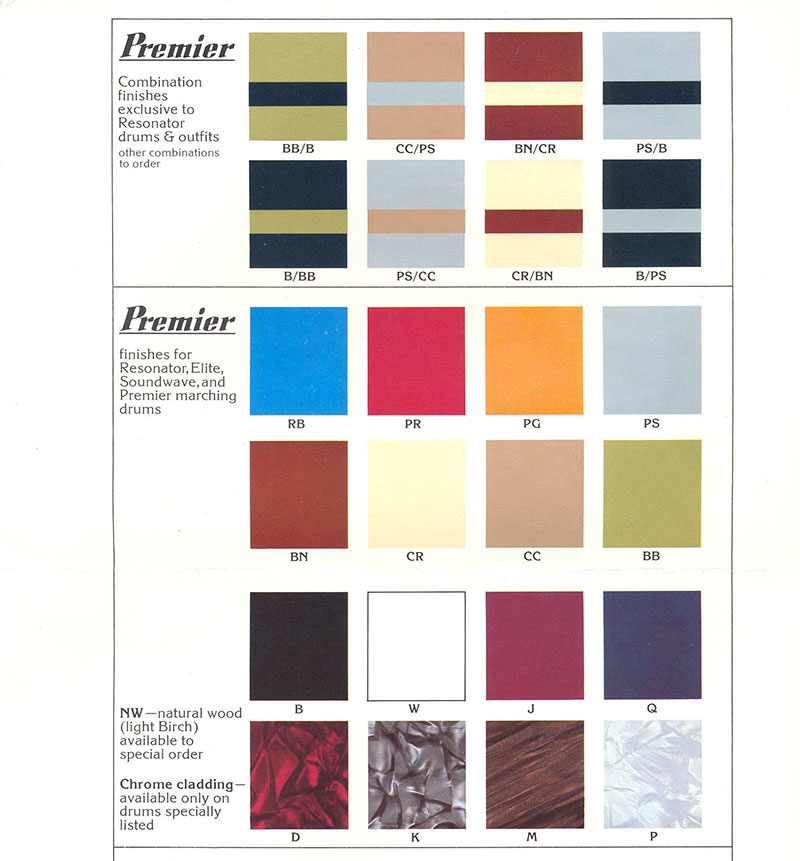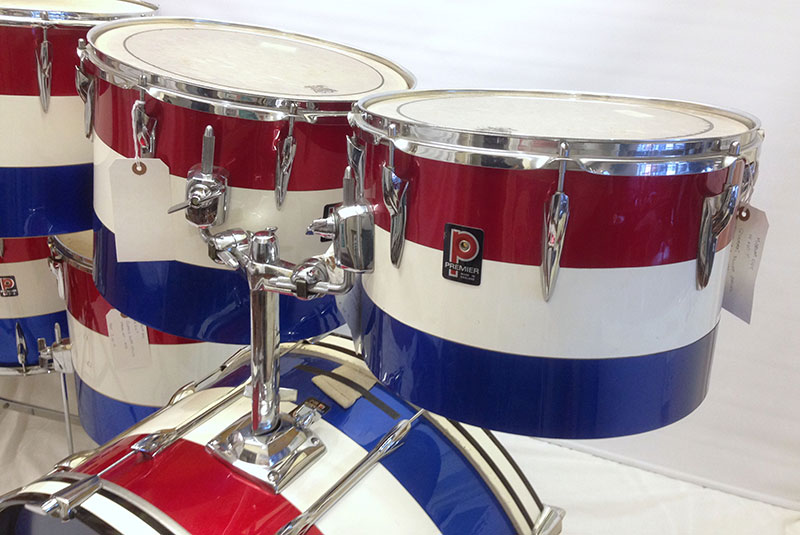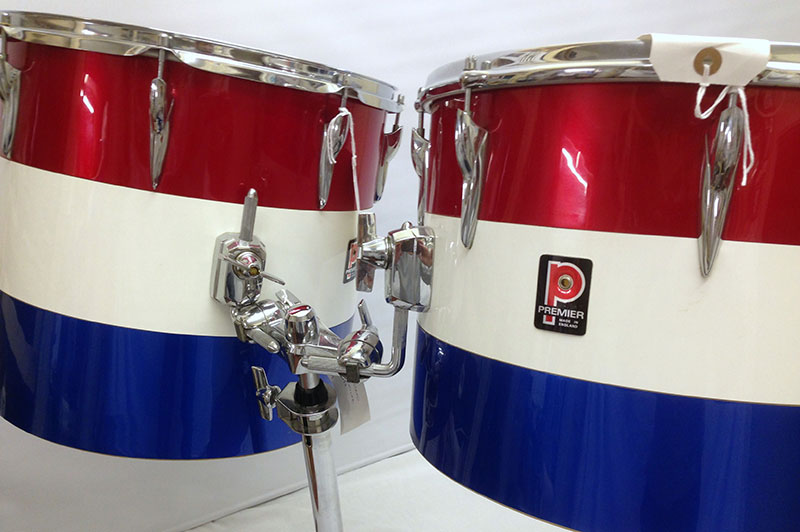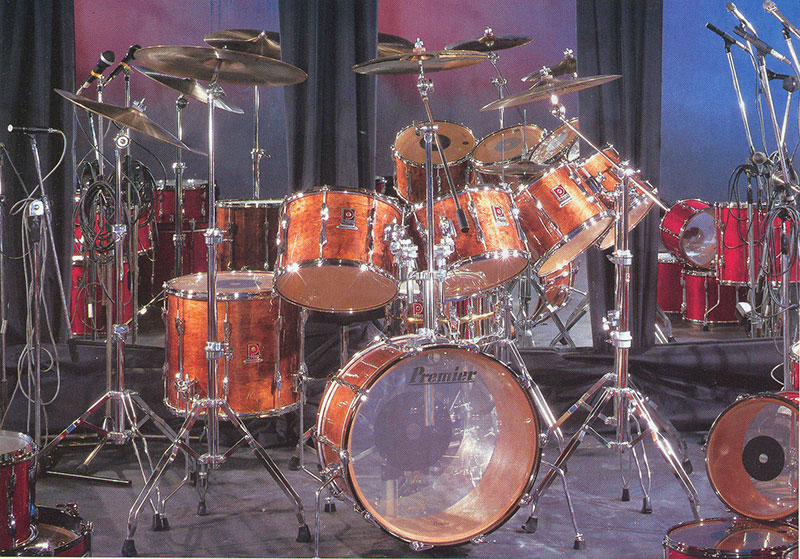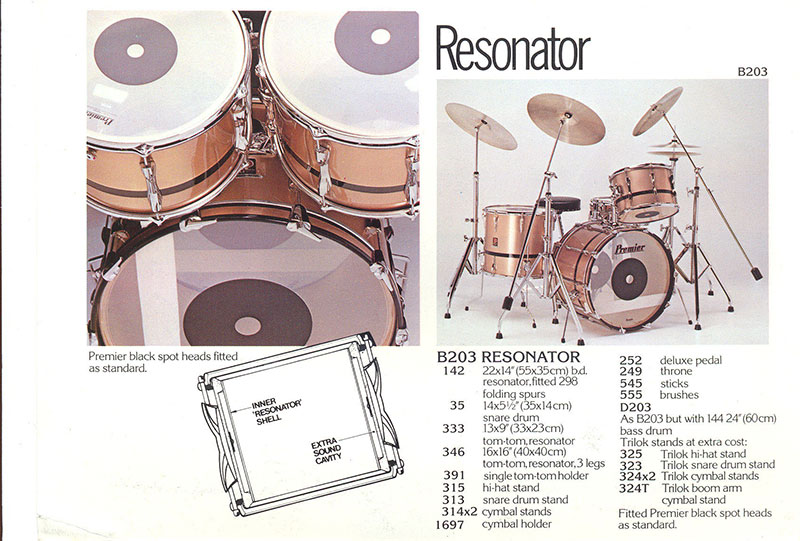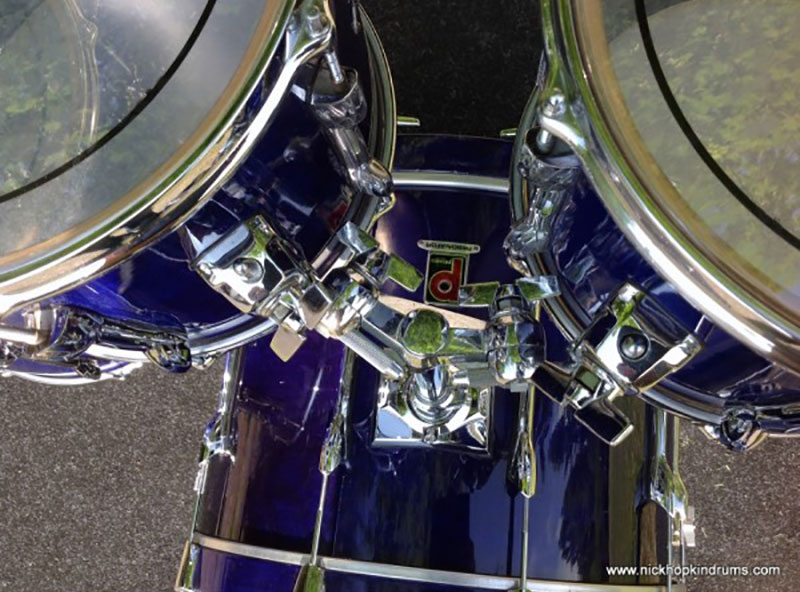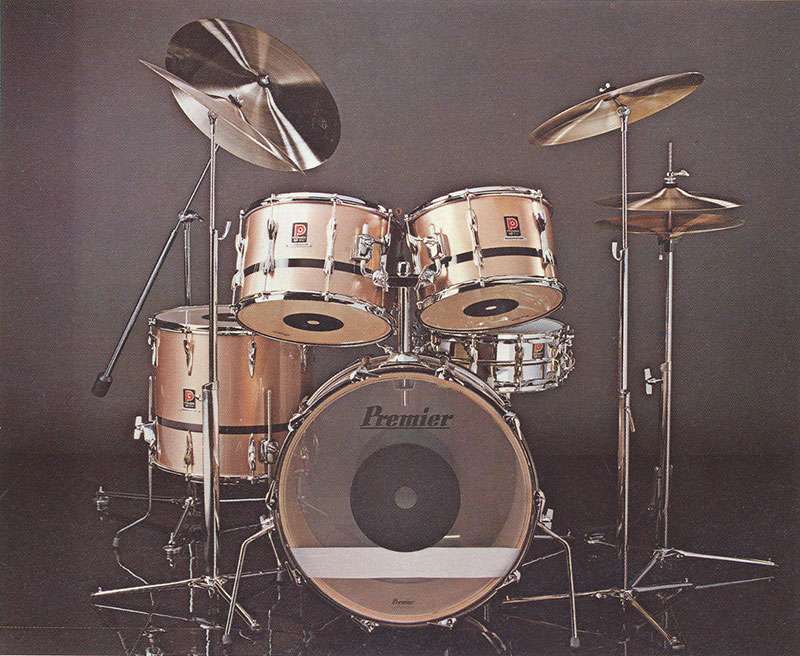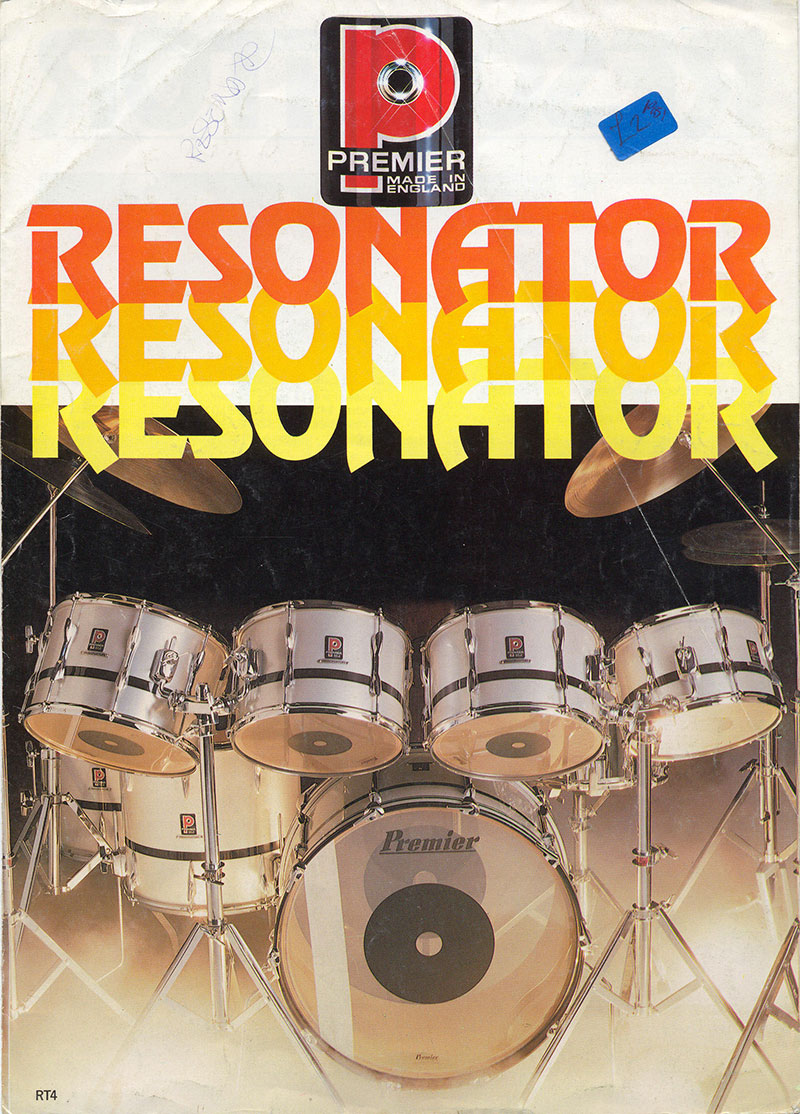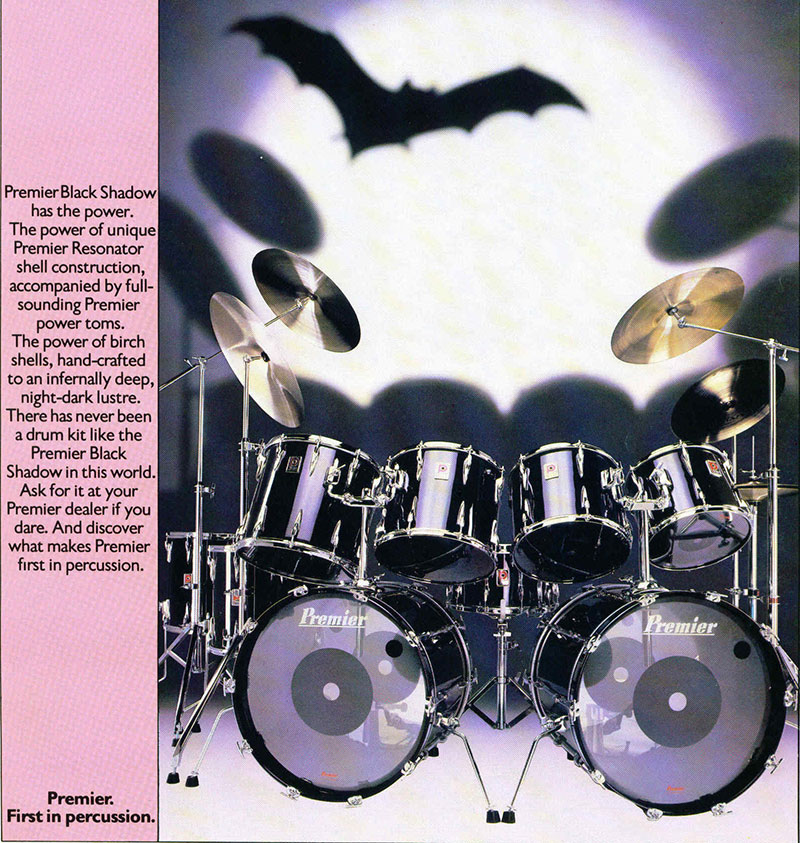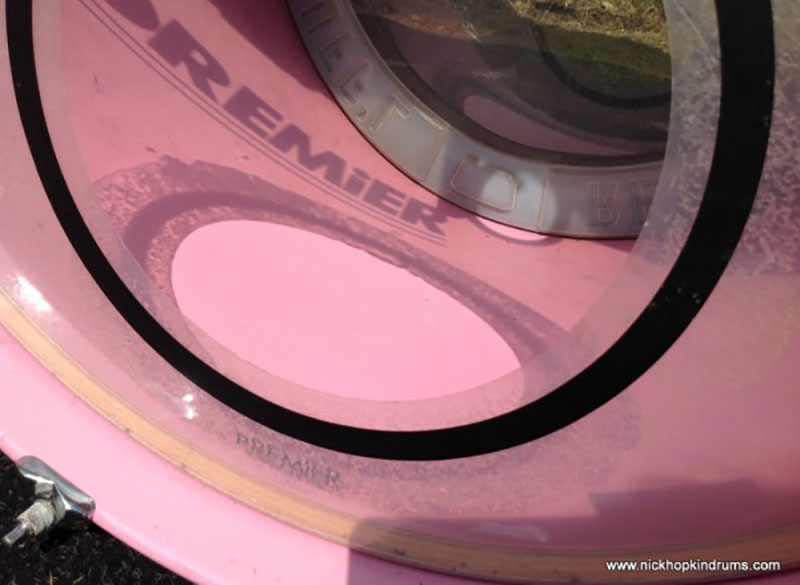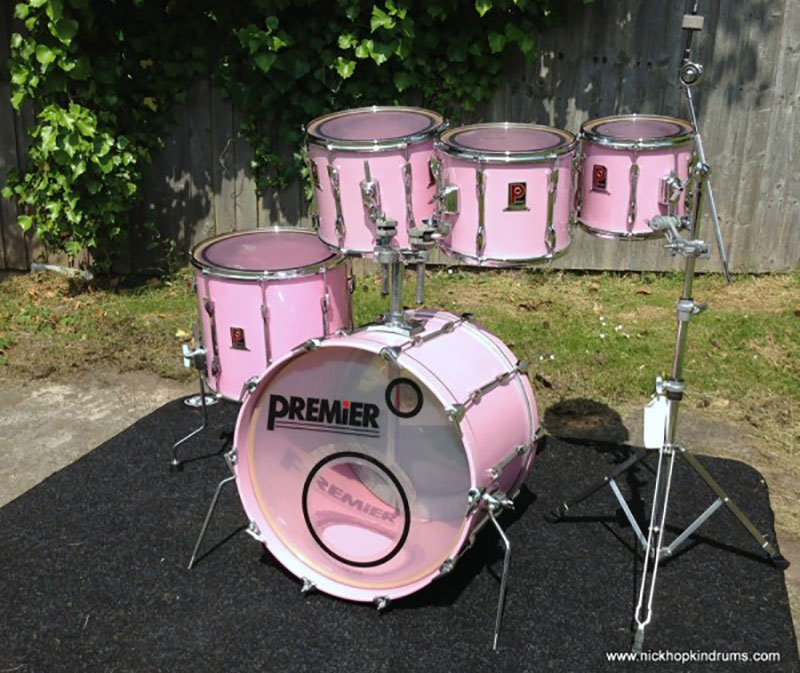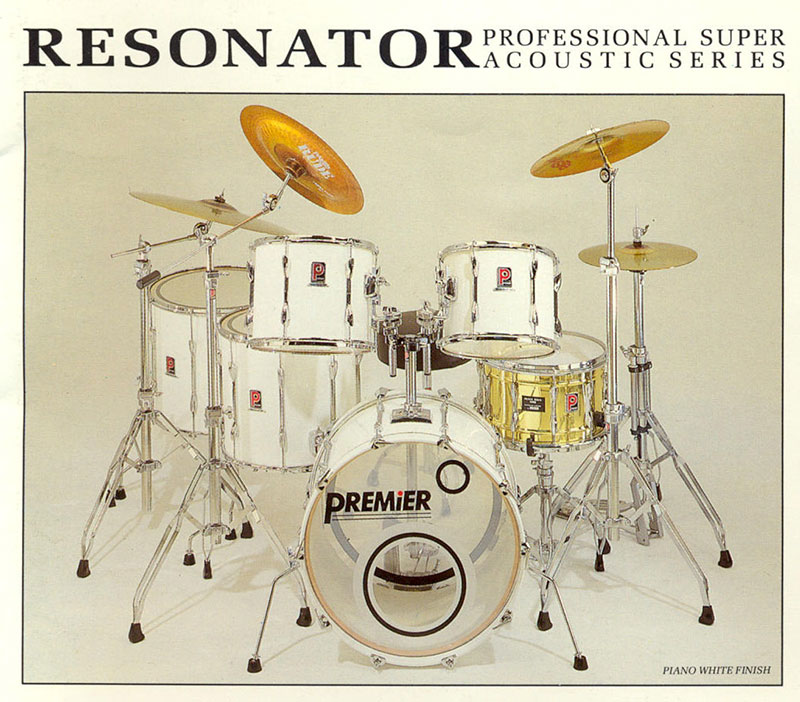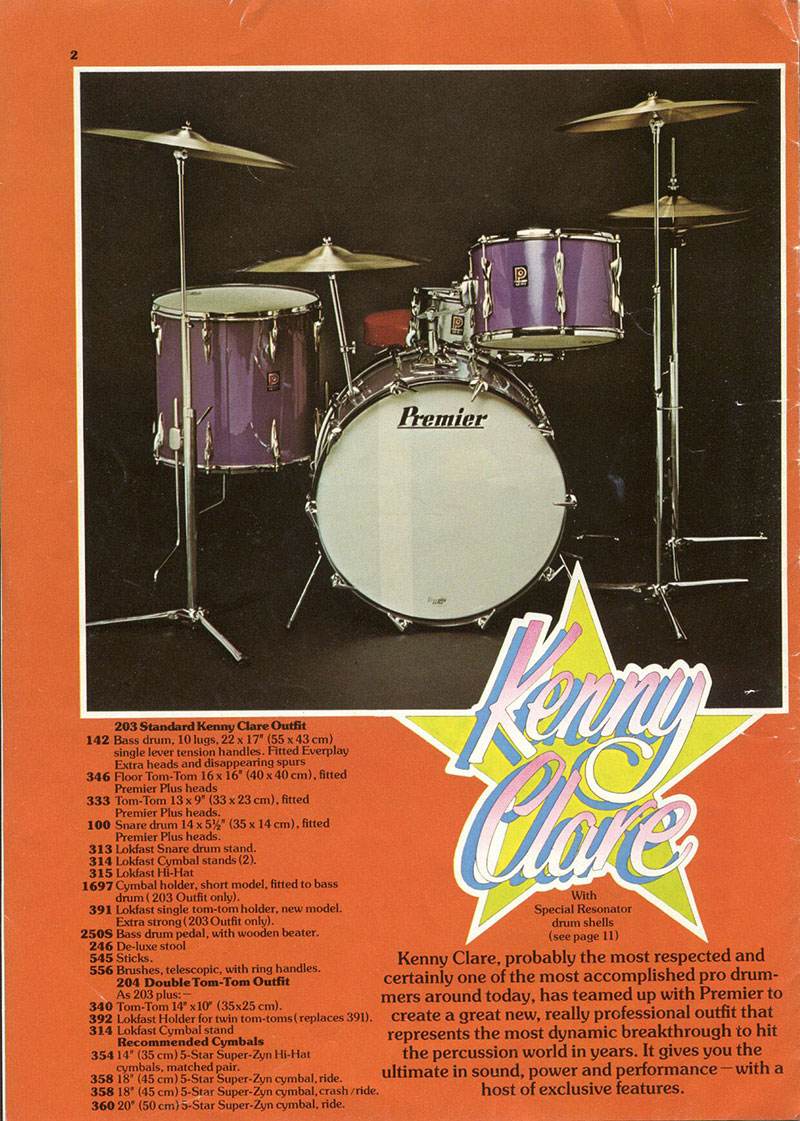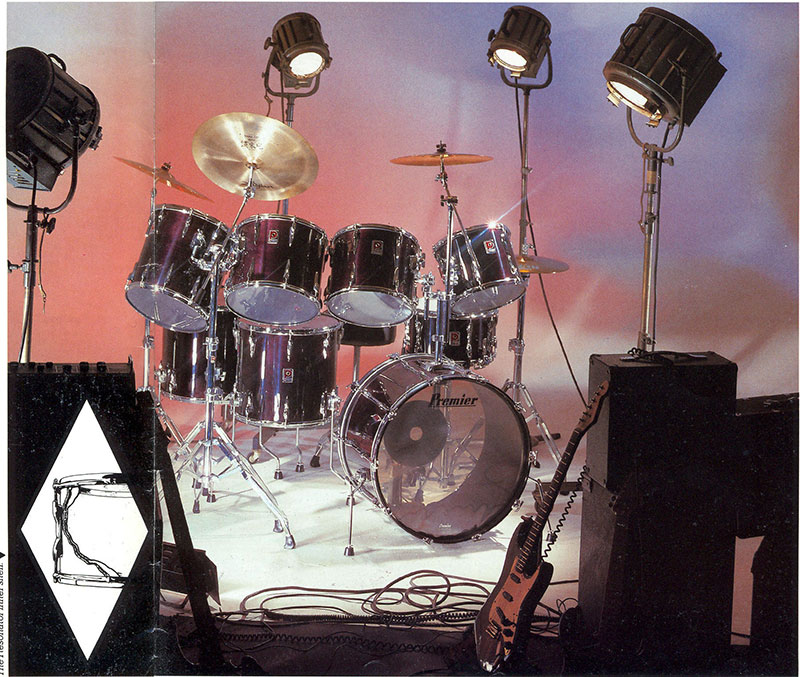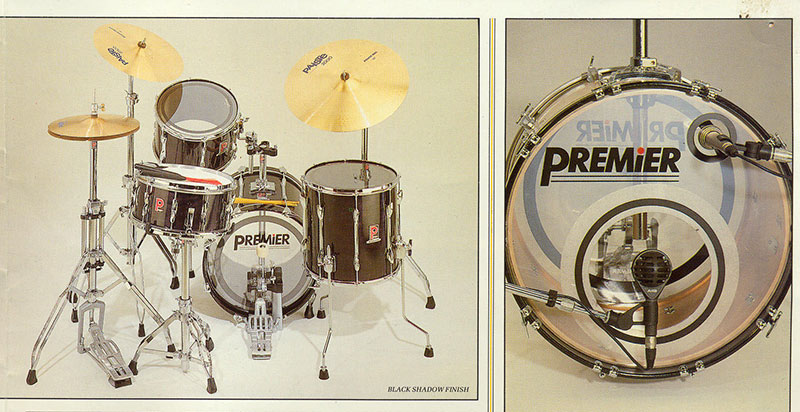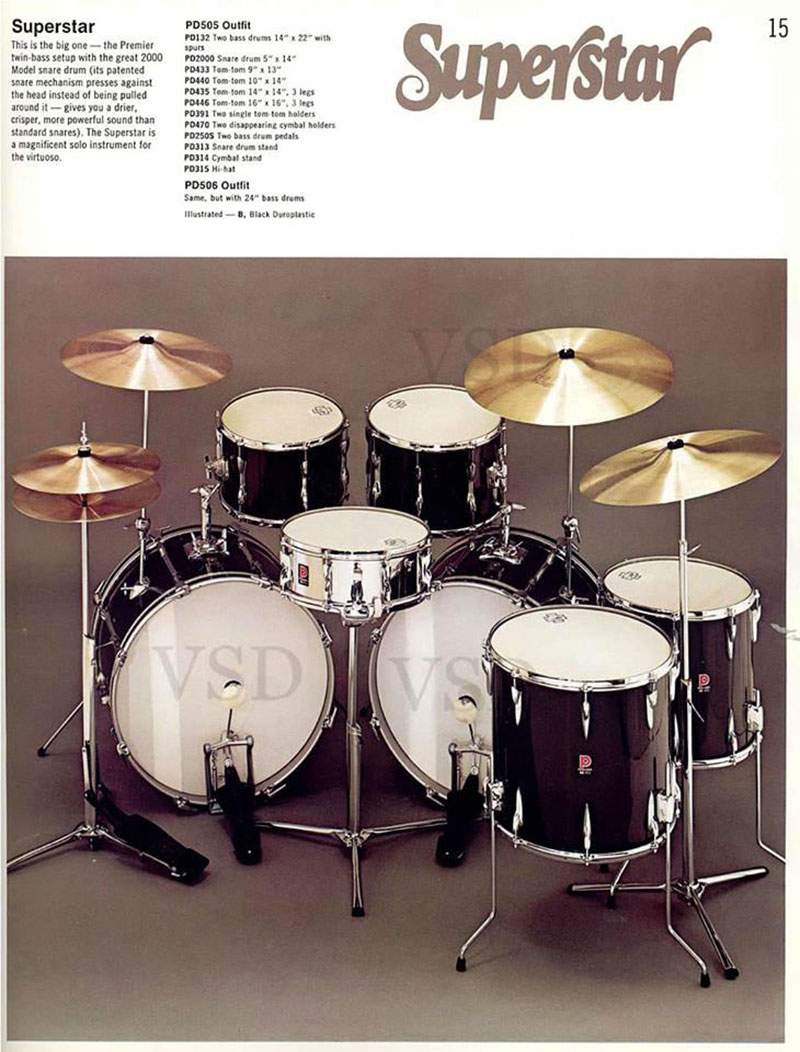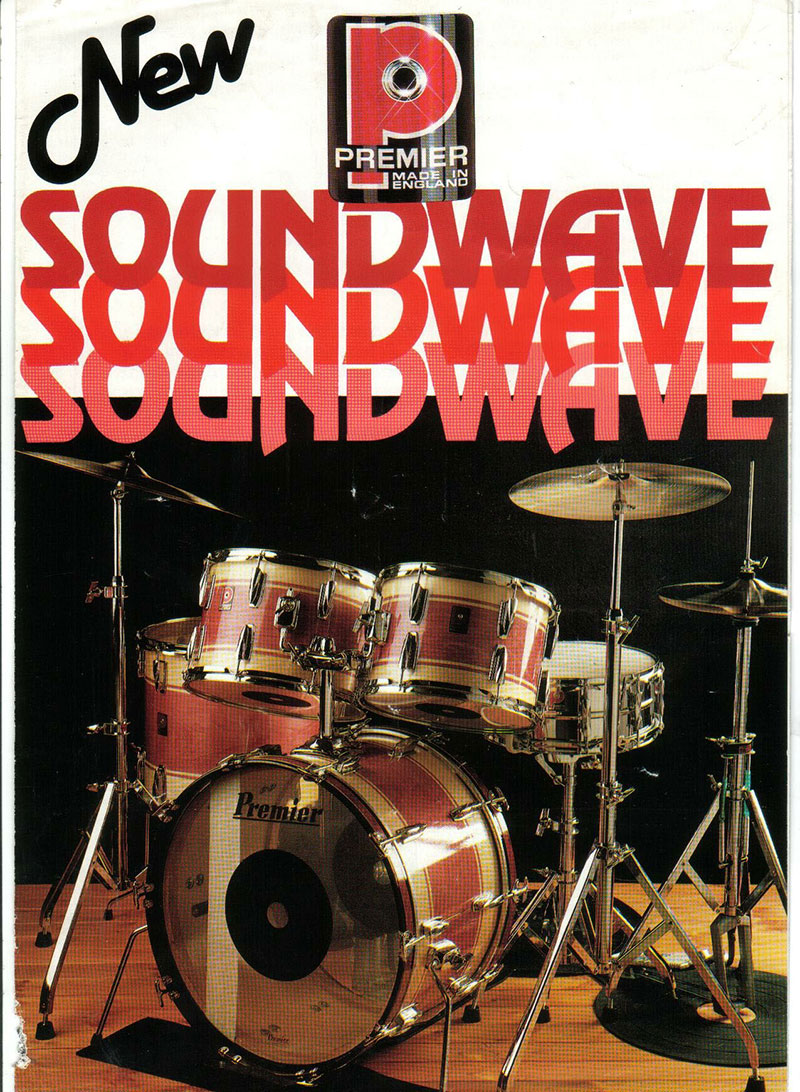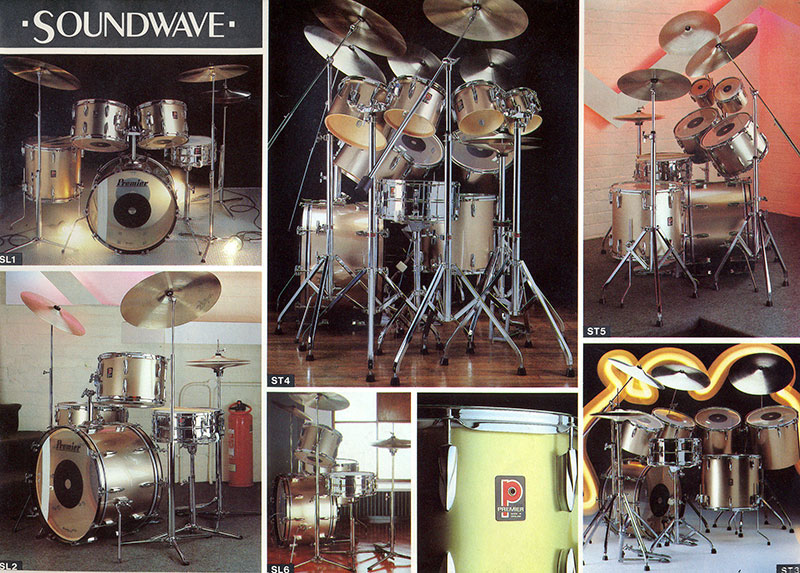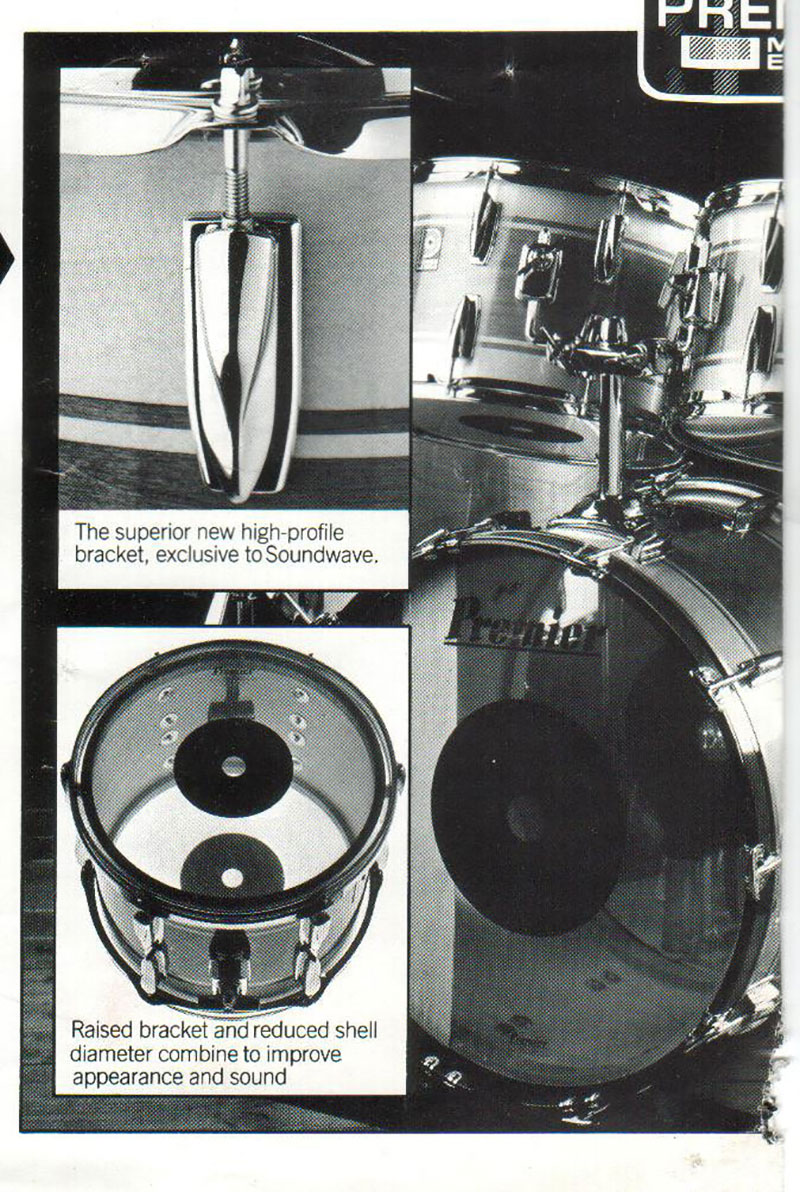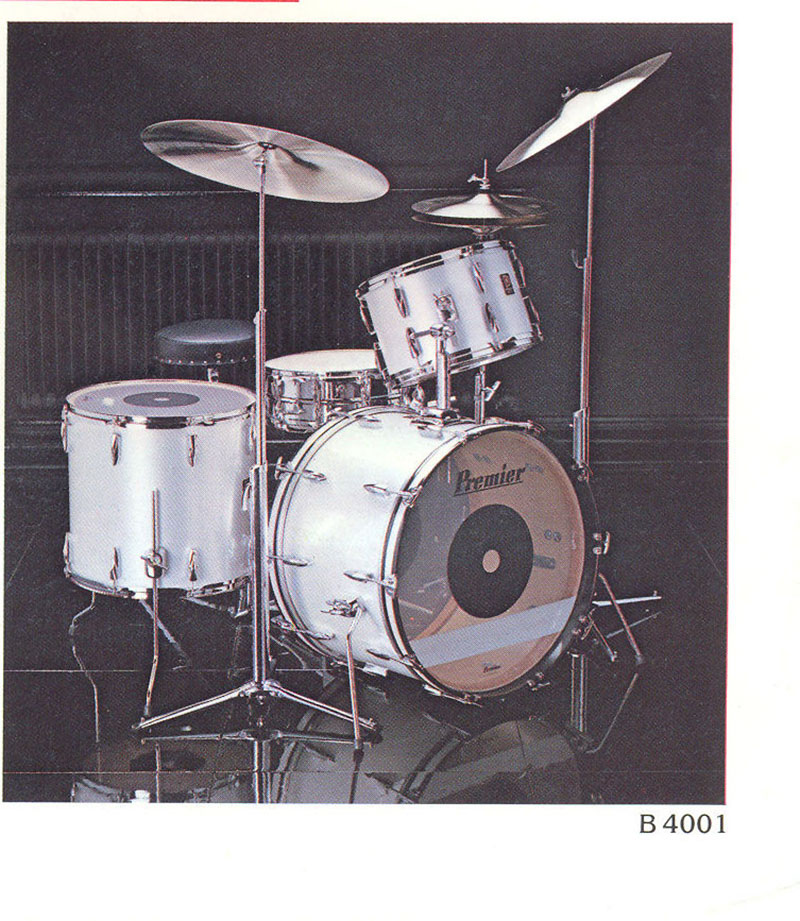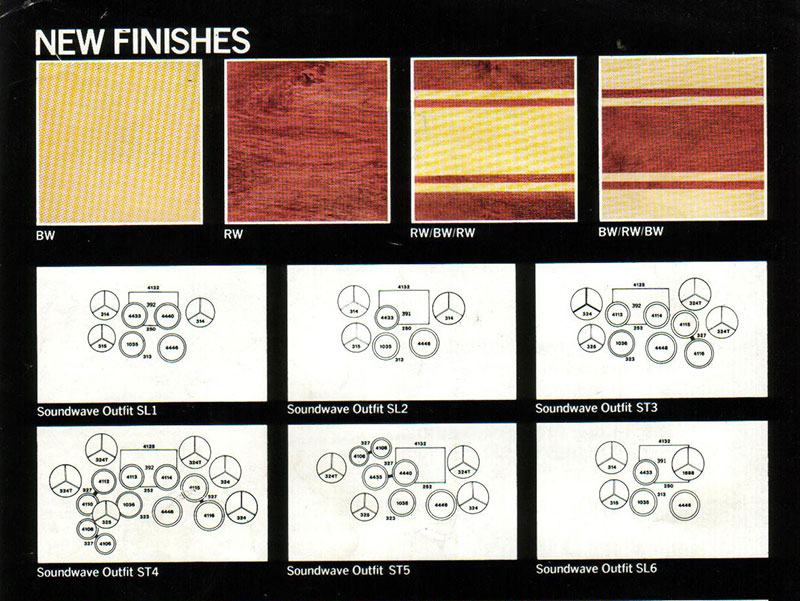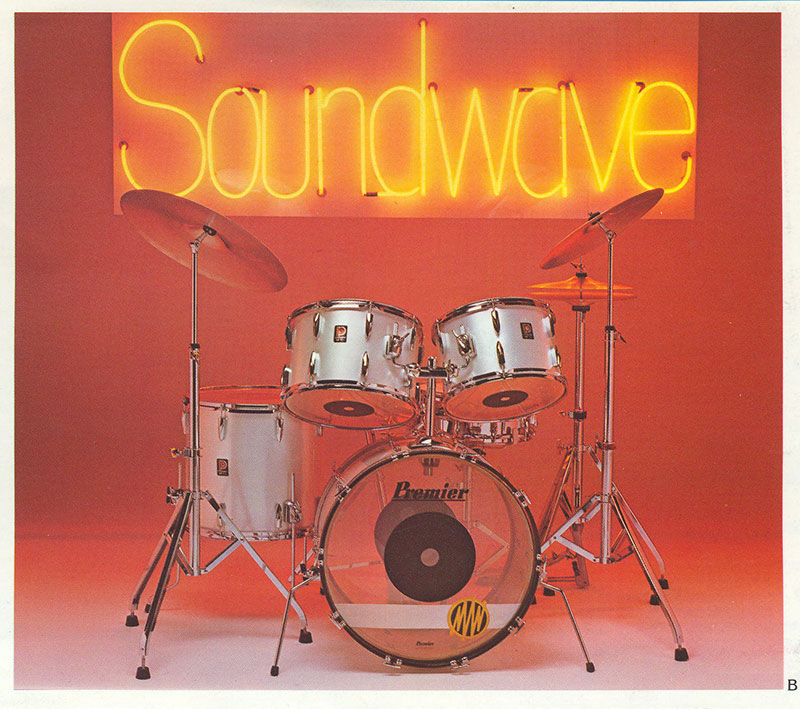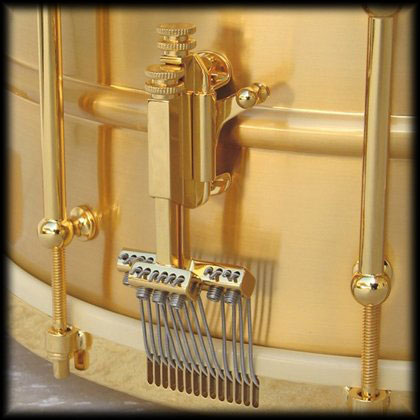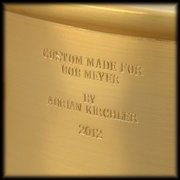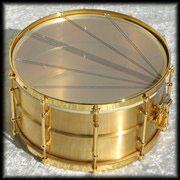So with the help of the master boat builder and much trial-and-error, Johnny began making his own one-ply drum shells. By 1984-85, Johnny had started to perfect his technique. Word of his drums spread until it caught the attention of Billy Gibson (Huey Lewis & The News). Billy asked Johnny to join forces with him to form a drum company, the Select (later changed to “Solid”) Drum Company.
Read moreGoodman Quilted Maple Stave Snare
The Goodman Drum Company sent in a very high-end snare drum for review that sounded great on my gig last night (and I’m pretty picky). The instrument’s body is a 14 by 5.5 Quilted Maple stave shell that is 5/8” thick and has a double 45 degree bearing edge. It has wide and deep snare beds similar to the old Slingerland Radio King bed which I personally like because of the responsiveness. The flawless, grade A quilted maple wood has a beautiful hand rubbed clear coat that takes two weeks to apply and has a UV inhibiting agent. The hardware on the drum includes ten polished solid aluminum center lugs with receiving tubes that give it the look of a tube lug drum, die-cast hoops, a Trick throw off, and Pure Sound snare wires. The 3 small unique snare vents in the shell are aligned vertically in one panel of the drum and sit flush with the shell. No cheap hardware on this drum. It appears they using only top shelf parts. The badge is die-cast with a script logo on a glossy oval background trimmed with a silver/chrome-ish border. Very understated tasteful badge.
Sound? This is a full-bodied snare drum sound. At high, medium and low tunings the fundamental note of the shell is very present. It was very easy to tune and the feel of the tension rods turning in the lug threads was very smooth. The resonance and sustain in the head was very pleasing and musical from the edge to about 2/3 the way in to the center at which point the head became progressively drier until it was very controlled at the very nodal point in the center. I like a snare that allows me to hit in the center for a dry, short, snappy sound but with the option of moving away from center to use the natural ring in the head for longer tones. The snare wires respond very well from edge to center and I was able to dial out sympathetic buzz from other drums with the Trick throw off . The snares sounded great at tight, medium and loose settings. I think this can be attributed to the superb bearing edges snare beds as well as the superior Trick throw off and Puresound snare wires. I’ve noticed that some snare drums with die-cast hoops can be very one-dimensional; too much fundamental and not enough overtones or splash, all crack and no tone. Not with this drum. The die-cast hoop did not “choke” the drum. I usually prefer a triple flanged hoop because I find that die-cast hoops don’t give me enough tone and splash. Not so with this drum. It had a lot of what I call nice “gonk” tone in the sound (think Bill Bruford), which I find is usually missing in many drums with die-cast hoops. I also noticed that the difference between a regular loud hit and a rim shot was not that different in volume, but it was different in tone, which was nice. I play a lot of rim shots on backbeats but did not feel the need to with this drum. Most drums have a much seemingly louder report with a rim shot but the wide range of dynamics of the head hits on this drum with regular hits speaks to the superior response of this drum’s design.
Performance; I took this drum on a three-hour gig with an Allman Brothers tribute band. It was a very loud gig in a small club with another drummer right next to me. I had no problem hearing this drum even though there was no monitor and I had a hard time hearing the little 18” bass drum I was using. I didn’t feel the need to hit rim shots to hear the drum. The tuning held up well. No de-tuning of the tension rods.
Cons? Nothing. A+
The Goodman Drum Company is a three-year-old boutique company run by Chris Goodman Jr. and Sr., who also make other wood products. They make their drums out of rare, re-claimed, exotic and high-end tonal woods. The moisture content of the shell is very controlled at 6 to 8 percent until the final clear coating step. The drums are trued on granite and it is obvious that they are very concerned with producing a flawless instrument with much attention to detail. The Goodman's have plans for expansion in the near future. Their first 13” snare will be introduced in a few months. Lugs, hoops and tension rods will be made in-house in 2016 and their first drum kit will debut in 2016. Their goal is to go national with distribution in 2017. While their website is under construction you can reach them on Facebook.
CUSH Pads for Cymbals
This is one of those reviews that is easy to write because the product is so simple that it either works or it doesn't. It either does what the manufacturer says it does or it doesn't. This one works! CUSH pads are an alternative to the felts you use on your cymbal stand. They are made of a proprietary elastomer material, and are designed to allow the cymbals to ring longer and truer without muffling the sound or overtones. They don't collapse or take shape and always return to the original shape.
Read moreMike Clark: Words of Wisdom, Part 5
Chapter number five in an ongoing series of commentary from legendary drummer Mike Clark. His storied observations continue to inspire, and provide keen insight into ‘all things music’.
---
I played double drums on a gig with Lenny White once and he took a solo all poly-outness while I held my place quietly on the 2 and 4. He took it so far out I was hanging on for dear life. But Lenny was right, and here is the kicker...I was proud of myself for keeping my place. But he was the dude that played everything. It was amazing, as Lenny knows where he is at all times… But it really sounded like he modulated into about 80 different time signatures at once.
I love Art Blakey’s playing, his bands, arrangements, his groove… When it comes to swingin’ – Is there anyone that can swing harder? Not for me.
Does anybody but me get tired of seeing and hearing the same 6 or 7 guys playing all the festivals and jazz joints over and over? Who's idea is that? Or if there is a new guy… He has to make up some wild way of playing that most of us had thought of and discarded.
When I play swing no matter how far out I go, I play it on the 2 and 4. Same with funk… No matter where I put the backbeat, the "Thing" if you will is on the 2 and 4. That’s what I do.
I remember when you had to play several different styles of jazz… Usually a few you really liked best. It was hard to make a living specializing in one area unless you had really good luck. Now it’s hard to make a living playing any of those styles. Now I see that several guys stay in one bag for a lifetime and do OK. For me, that would be like eating eggs every morning forever.
Elvin Jones said he wanted to be part of the scene, but didn’t want to play in a conventional way. Elvin really didn’t hear that, and he was severely criticized for it. Being with Coltrane solidified his concept, and his words. How would things be if he didn’t have the good fortune to get that gig? How would things sound today?
I went to a mix when Tony Williams played, I was listening to the playback and the time sounded a bit soupy, Tony walked by the board and pushed the fader up to the top and the track swung incredibly, and it sounded like Tony. The engineer cried and whined about the fact that it red lined. Tony said, “the red line - that’s how jazz is supposed to sound”.
I admit it - when I played with musicians having great careers, I would be kind of nervous since I wanted what they had. While playing with Herbie Hancock, there was none of that. He was so famous I guess my brain processed it differently. In the last five years I’m finally over it. I really enjoy playing with anyone, no matter how much they’ve got. As long as the music is cool… That’s the end of it…I am actually in the moment. It took a lifetime… But better late than never!
When mixing drums for jazz, I would suggest listening to some old Blue Note records as many times as possible. Now the drums are compressed like a pop record and the tuning seems to be in between what used to be jazz tuning and pop or fusion. Also, the groove is in the ride cymbal… So don't turn it down and have it sound like mush.
Joyful Noise appoints Todd Trent as Chief Operating Officer
Joyful Noise Drum Company is proud to announce the appointment of Todd Trent as their Chief Operating Officer. Todd is excited to bring over 3 decades of percussion industry experience to Joyful Noise. Having been in music retail, artist relations with Ludwig Drums, wholesale / OEM sales and marketing with Taye Drums as well as pro touring management, Todd is well suited to propel Joyful Noise. He has been a fan of the product, their mission and leadership team since the beginning of the company and now feels the time is right to add his abilities to such an outstanding company.
1934-35 Slingerland Broadcaster
By Mike Curotto
Hi all,
Here's another one cleaned up and entered into the collection. I got this snare drum at the 2011 Chicago Show from our good friend and fellow collector, Mark Cooper of Cooper's Vintage Drums.
1934-35 SLINGERLAND 6.5 x 14 SPARKLING GREEN/ARTGOLD *BROADCASTER MODEL
*The Broadcaster Model was very short-lived so for those of you that may not be familiar with this model here is a short history and background data regarding the Slingerland Broadcaster Model. The following is from Rob Cook's Slingerland Book (first edition): "The Broadcaster was evidently a forerunner of the Radio King, the strainer is a very early Radio King style strainer and the lugs do not have inserts. (The tension rods thread directly into the lugs.) The muffler was the single-pad style Harold R. Dodd muffler." Thanks again to Rob Cook. I have also read that Slingerland was legally forced to discontinue using the word "Broadcaster" (with a "c") as the Fred Gretsch Co. had been using the name "Broadkaster" (with a "k") on their drums way before Slingerland and therefore the court ruled in favor of Gretsch that Slingerland's Broadcaster was too close sounding/looking to Gretsch's Broadkaster.
The Shell: The Sparkling Green wrap was in pretty good shape with very few of those black "cancer" spots that usually show up on these older Green Sparkle drums. I was able to get a few layers of age off of the wrap with my Maguire's cleaning/polishing regime and the Sparkling Green finish came back to life. The solid maple shell interior was also in good shape and only needed a very light cleaning. The cloud badge was tight and weathered the last 75+ years pretty well.
The Hardware: I'll call it Slingerland Artgold but the hardware finish on this snare drum really resembles the Ludwig & Ludwig Classic Gold (brass plating with gold lacquer) finish that L&L used on their early-mid 1930s Black Beauties. There was a lot of Artgold present but an equal amount of age and tarnish. I haven't figured out how to duplicate the Classic Gold finish yet so the decision was to leave the hardware as is and just do a simple cleaning with a light coat of gold lacquer to seal everything to prevent any further tarnishing. The 16 tension rods were not correct so I went to my stash and found the correct tension rods but these had to be brass plated, antiqued and lacquered. Thanks again to Les and Brian Hadnagy of Avenue Plating for the brass plating and antiquing. The threaded snare gates have the letter "A" stamped on the inside (not seen) part of the rim and gates. This is called a "manufacturer's cartouche", thanks to Slingerland expert Dr. Carl Wenk for that information. I'd love to know if those type of markings are under the riveted snare gates, feel free to send photos. The Slingerland Broadcaster engraving on the top rim is pretty faint but it is there. All in all, the "carpet matches the curtains" pretty well on this drum.
Of-the-era calf heads and extension wires rounded out this cleaning/restoration.
Enjoy!
1960s Gretsch Name Band
Greetings,
I have some great friends who love, collect, and play vintage drums. It is indeed a pleasure to share this common interest.
My editor has put harsh and undue pressure on us to get an article out in time for the Chicago Show. I'm kidding about the harsh and undue part. The editor is really a nice guy, and we all love him and appreciate what he does to get us out a magazine about our passion every month. If you don't think he is doing a great job, you should try to do it. I am hoping I can be at the Chicago Show this year so I can see all my collector friends, and share some time together looking at and hopefully buying some new "toys." Getting to know and keeping in contact with friends who love these old drums is one way to know about good deals for buying, and also it opens up contacts for selling your items when you want to or need to move something. I would much rather sell to a collector friend than ship a great drum off to who knows where. I am not knocking those who sell their drums out of the country, but once that Black Beauty leaves this country it's definitely gone for good. I will get some negative comments about this for sure.
The set I am featuring this month is a 1960s Gretsch Name Band set in blue sparkle. Sometimes I have to tell you why a set is cool, but I don't think I have to tell anybody how cool this kit is. The set is made up of : 20"X14" bass drum, 16"X16" floor tom, 13"X9" ride tom and a very cool 14"X5" matching snare drum. The snare has eight lugs and the Micro-Sensitive strainer. An alternative 22"X14" bass drum was also available in the PX4015 Name Band set 1961-1976. These drums sound great. The shells are six ply with silver sealer inside. The blue glass glitter finish is still very strong and vibrant on these fifty plus years old drums. It is a joy to own and play an old "round badge" Gretsch drum set from around this era. The die cast hoops and distinctive hardware give them a distinct look. What I would call a timeless classic look. They are truly beautiful.
I was saying how great it is to have friends who also share an interest in vintage drums. I bought this drum set from Bill Pace many years ago when I was just starting out collecting. One of my oldest and best "drum friends" is Bill Pace from Forsyth, Georgia. I have been friends with Bill for a long time, and I can truly say with all our drum trading he has always been fair with me. I have tried to do the same with all my drum trading as well. We need to have some ethics and deal with people in accordance with the "golden rule." You know that one, right? "Tell all the issues with the drum to others as you would have them tell all the issues to you." I know you do that already because you don't want a negative feedback. In the old days the only negative feedback was you got a bad name if you didn't deal fairly. Bill is quite a character though. He will work hard to get a good price selling his drums, but he will work even harder to get your drums at a good price.
The funny thing about this set I am showing you is it was bought by Bill at a pawn shop. When he bought the set the floor tom I now have with the set was not with them, instead the set had a MIJ 16"X16"" blue sparkle floor tom. It was a Jet model drum. When Bill bargained with the poor owner of the pawn shop he really focussed on the Jet floor tom. He acted so disappointed that the set didn't match etc. etc. etc. The set was sold for a lower price because of Bill's whining. He sold me the set as a "One Nighter Plus" which was listed in the catalog without the floor tom. I later added the floor tom I now have to make the set a "Name Band" outfit.
Vintage Bass Drum Head Artwork
This is one of those reviews that is easy to write because the product is so simple that it either works or it doesn't. It either does what the manufacturer says it does or it doesn't. This one works! CUSH pads are an alternative to the felts you use on your cymbal stand. They are made of a proprietary elastomer material, and are designed to allow the cymbals to ring longer and truer without muffling the sound or overtones. They don't collapse or take shape and always return to the original shape.
Read moreCustom Drums: Really, Why So Pricey?
At one point in my life, I worked for an advertising agency – you know, the Mad Men thing. (Yes, there really were three-martini lunches.) A lot of prospective clients would ask us, in the course of getting acquainted, “How much is a brochure?” And the head of the agency would always answer, “How much is a car?” or whatever the client sold.
The answer depends completely on what kind of brochure, or car – or drum – you’re talking about. It’s all relative, and all about your needs, your goals, and your priorities.
My last article, about why custom work takes time, led me to another basic question: why custom drums cost what they do. You might find, or have found, yourself experiencing sticker shock over the price of a custom kit or snare. But usually that’s about expectations; you may be comparing the price to mass production drums, or you may be comparing the price to doing it yourself. But, in either case, why the difference? Let’s take the case of custom vs. mass-produced. Really, when you stop and think about it, why can’t the small, independent companies get the job done for less than the big guys? They’re not carrying the payroll, advertising expense, or sales teams. They’re not paying for big facilities or a huge stockpile of parts.
So why can’t they make a drum for less? It’s largely a question of scale and capital investment. A big company can commit lots of money to major orders from a supplier, and they may even have a financial interest in the supplier’s operation. Being that important to a supplier means they’re in a position to negotiate very favorably on terms and pricing. There are also advantages in limiting the choices – a major manufacturer is rarely going to offer more than a couple of lug styles, and usually only a few shell types, allowing them lots of inventory without the risk that it’ll sit on the shelf unused. So ordering ten lugs (small inventory, wide selection) produces a very different per-unit cost than ordering ten thousand lugs (big inventory, narrow selection) does; the pricing advantage goes to the big guys.
And, yes, the large manufacturer’s investment in tools and equipment is enormously higher. But paying for those investments has to come out of sales, so the smaller shop’s equipment cost might be divided over a few hundred kits sold over a period of time, while the big brand’s investment is covered by thousands of kits over a similar period, lowering the cost each sale needs to cover.
And then, of course there’s the question of labor cost. A big manufacturer needs to maximize efficiencies and minimize hours in order to meet a specific competitive selling price. A small builder, on the other hand, may want to put in more time because it allows the most effective end result for him, or because he’s addressing details that are not cost-effective for mass production, or even because he loves the actual hands-on process more than the business-operation side. I remember a conversation with a builder who told me he could wrap an entire kit in under an hour – and my reaction was, “What’s the fun in that?”
That brings me to custom vs. do-it-yourself. In this case, the comparison just isn’t fair. Yes, you can say that DIY is a way of saving all that labor cost, but it’s not exactly an apples-to-apples thing. You may have tools to build with, but the odds are good that the builder has tools that are more precise, more controlled, and better set up than yours. And in many cases, the builder may have access to parts, materials, or services that you simply can’t get.
Admittedly, doing it yourself saves on the overhead even a small builder has to cover – dedicated work space, maintaining shop materials, financing cash flow, managing bookkeeping and correspondence, website, etc.
But in terms of labor, the number of hours is only part of the story. A good custom builder brings a lot of background to your order. He’s seen different grades of parts and knows the ins and outs of working with them. He knows dozens of nuances about fitting and finishing, and the behavior of materials and shapes over time. He knows how to make design decisions to help get you the sounds and performance you want. It’s part of what he charges for – expertise that gets you much more than just a drum. Yes, you can put it together yourself, and you can even farm out some services like edging, drilling, and wrapping, but a good custom builder brings much more to the equation and the end result is not the same, even though the parts might be. So when you judge the price of a custom drum or kit, don’t evaluate it in the context of the price of a mass-production item or the cost of doing it yourself. Judge it in terms of its value to you – if it costs more, are you getting more? Is it better quality, better designed, or more exactly what you want? Does it perform better, feel better, or sound better? If the answer is yes, you may actually be getting more for your dollar from custom drums.
April 2015 - Spring is Here!
My friend Rob Kampa has been a busy boy. Rob, of MagStar Drums fame, is one of the first and best of this generation’s custom drum builders. He moved to Nashville a while back and has been doing all the drum building and custom work for Andy Foote’s Drum Supply House for quite a few years. Rob and his wife Maggie have recently become the proud new owners of WorldMax USA, leading parts supplier to the DIY and custom drum building industry and makers of the infamous Black Dawg line of brass snare drums. I was wondering for a couple of years who previous owner Walt Johnson was going to hand the baton off to when he retired, and I can’t think of more suitable owners than the Kampas. If that weren’t enough to keep his day full, he is now also building drums for the resurrected Walberg and Auge Drum company. Jeremy Esposito is the other name in the W&A venture and has set it up as a non profit company. Much luck , Rob. You are now a cornerstone of the drum smith community. We need to do an article on you and the three drum companies you work with.
Not So Modern Drummer will have a booth at the Chicago Drum Show in May. I won’t personally be there because I have some performances I can’t get out, of but our Production Manager Chris Speich will be there along with Aaron Mlasko of Mlasko Drums here in Nashville. Please come by out booth to say hello to Chris, maybe talk about some advertising in NSMD, and to check out Aaron’s cool drums.
Matt Crouse interviewed me recently for his very cool podcast "Working Drummer". It's a conversation about what it is like to be a lifelong working drummer, my history and experiences, and Matt's take on things too. He is very good at this and I'm so glad he included me. Matt is an old friend. We met twenty years ago when we were both working at Fork's Drum Closet. http://www.workingdrummer.net/2015/04/15/georgelawrence/
I have resurrected the Famous Drums brand with a new work horse Black Beauty brass model featuring a Dunnett throw off. It has a low price of $385 and you can check it out at our Reverb.com storehttp://rvrb.io/2015-black-beauty-70g
The Snare Drum Olympics will be held this year. The judging will be in November and results will be published in the December Issue. If you want to enter a drum or two or three in this year’s contest and publicity event please sign up on our mailing list at www.snaredrumolympics.com and review the application and procedures. Since the Nashville Drum Show is not being held this year, we will have a separate public event for the public judging and debut.
There are many great articles in this issue including a healthy number of reader submissions and appraisal requests, so get our your iPad or your telephone or your Dick Tracy watch and read away. –George Lawrence
PS - Don't forget to check out all the new products in our new store: https://reverb.com/shop/georges-drum-shop
Drums & Gliders
Something different!
Read moreJoe Richardson's Leedys
This is about the best recent shot of my Leedys. The shells are a little more yellowed than this picture shows—too many times playing in smoky places. Our band broke up last week. Our leader (sax) died suddenly. It’s hard to find older guys who can play the forties music—or just play at all. Not quite ready to sell yet. As you can see, I keep white heads on them. Black or transparent heads just would not look right on them. The front head on the bass is original cowhide with my shield and bars with my initials, ala Krupa and Rich.
I’ve played some drums with plastic shells and some electronic—just don’t sound right.
-Joe
Canopus Neo Vintage Snare Drums
Canopus sent three unusual snare drums from their Neo Vintage series for me to review this month: I’m including their specs and descriptions as well.
NV70-M4 (4th of Neo-vintage series)
Shell : 5ply Maple + Poplar 9mm Finish : Superior Maple Lacquer Size : 6.5 x 14 Top Hoop : 12 tension round edge hoop Botom Hoop : 6 tension round edge hoop Snare Wire : Non-plated Canopus vintage wire (CPSL-14DR) Lug : Japanese sword separate lug
MSRP : $1530.95 MAP : $918.57
From Canopus’ literature:
"NEO VINTAGE M4 is based upon the technology and specifications of some outstanding drum designs from the 1970s. Its unique design features 12 tension rods on top and 6 on the bottom. A 5 ply maple and thicker poplar shell construction, and Canopus' precision bearing edge shaping, combine to create a characteristically "mellow and dry" vintage sound. With these specifications - providing a blend of tight attack and a comfortable, loose reverberation, it is a totally unique instrument. Certainly, this conspicuous sound will be highly prized and sought-after by a great many drummers."
Reviewer:
I found this to be the most intriguing of the three drums. I started out with medium tuning. Great sound and throatiness in that range, but the low tone of the poplar and maple shell begged to be tuned down. So I loosened the twelve top tension rods considerably and found the sweet spot on this drum. It makes a great “fat back” drum. The resonance of the drum at the low tuning has just the right amount of “gonk” in it. This would make a great recording drum for those who like to tune low and splashy. I also tried it at a tight tuning, not expecting much from the poplar in the shell but was surprised at how nice and snappy it sounded. Very articulate. I especially like the Slingerland type stick saver hoops. Something about those hoops makes a drum sound “rounder”. It’s the perfect compromise between a softer triple flange hoop and a stiffer die cast hoop. The 12/6 ratio of top to bottom lugs is cool. With the stiffer stick saver hoops, the 8 lugs are not needed on the bottom head, but I would like to hear one of these with 8 lugs on the snare side. The lacquer finish on the maple outer ply is flawless. The Japanese Sword lugs are the coolest thing. Why did Sonor ever let that style go?
SIG-1465YE1 (Yoshihito Eto's Signature Model)
Shell : Maple&Birch Hybrid 8ply Finish : White Satin Wrap (Inner Ply Black Oil Finish) Size : 6.5 x 14 Hoop : Die-Cast BlackNickel Plated Snare Wire : Non-plated Canopus vintage wire (CPSL-14DR) Lug : Solid Brass Tube Lug Black Nickel Plated w/ Inner Muffler w/ Tension Adjustable Butt
MSRP : $1359.36 MAP : $815.62
From Canopus’ literature:
“In order to suit the eclectic playing style of drummer, Yoshihito Eto, his signature snare drum needed the capacity to shine in a wide variety of musical situations - from Jazz to Pop and Hard rock. It needed to be a true "all-rounder", but at the same time it needed to reflect Eto’s playing personality. This was a major challenge - because it is often observed that an "all-rounder" snare drum seems to lose a certain individual character in order to function in all musical situations. Canopus produced many prototypes of this model - in search of the perfect combination of sensitivity, power, "clean" tone, and "complex" sound. We have met the challenge and realised this ideal sound. This drum features a hybrid shell - a perfect blend of maple and birch. The maple provides clear, clean projection and birch adds complexity and character to the sound.
To fully realise the potential of this hybrid sound, we have achieved a perfect balance of several elements - we have utilised Canopus' precise edge shaping, snare tension adjustments at both strainer and butt-end - to control the snare wire more efficiently, and an internal muffler which allows the tone to be controlled and varied at any time - even mid-song! The potential of this snare drum is infinite - all elements of the sound can be directly changed and controlled by the player. This is a remarkable instrument, of which the Canopus company is justly proud.”
Reviewer:
Beautiful drum with great color scheme: white satin flame wrap and black hardware. Very clean sounding. The die cast hoops give it a stout voice, but does not dry the head up completely like I’ve experienced on other snares. The snare response is very nice at tight, medium and loose tensions. The tension knob adjustment on the butt end is a nice feature. I especially liked the internal muffler. I‘m not a fan of muffling but on this drum the muting was effective without choking the head. It would make an all around workhorse drum that would be at home in many music genres.
NV60-M3 (3rd of of Neo-vintage series)
Shell : Phenol Fiber Finish : Deep Ocean Wrap Size : 5.5 x 14 Hoop : Steel 2.3mm Snare Wire : Plated Canopus vintage wire (CPSL-14NP) Lug : Solid Tube Chrome Lug
MSRP : $946.67 MAP : 568.00
From Canopus’ literature:
“With these unique drums Canopus has brought back the drum sound that was immensely popular from the mid 1960's through to their peak in the 1980's. Since that time fiber drums have become increasingly difficult to find. Fiber material has particularly unique sonic qualities when compared to wood or metal shells.
Canopus' process is to layer "craft paper" with phenol resin and apply a heat treatment (known as annealing) to the shell. This allows us to considerably harden the surface layers of the shell to get the best sound as a drum shell and extract the optimal sound. The combination of ideal shell hardness and thickness, combined with the perfect bearing edge, has allowed us to recreate the vintage fiber sound - Neo Vintage M3.”
Reviewer:
Warm, and deep. Not at all what I expected from this unusual type of shell. Very meaty and throaty tone. Easy to tune. Snare response is great. The tube lugs keep tension off the shell and add to the resonance of the drum. I would love to have this drum in my arsenal.
We come from the land down under - Australia’s Drouyn & Drouyn Drum Company (1928-1990)
by Tony Moore
When we think of vintage or classic drums, great drum makers, innovators, pioneering drum companies - those giants of our drum history, the founders of the inheritance that we now enjoy, those innovations and the men and women who made them - only a handful of people would know to include Australia's Drouyn & Drouyn drum company. Even less would know of their chief designer, engineer, innovator and drum maker, the great George Meacham.
For this, my first article for Not-so Modern Drummer, I'd like to introduce or reintroduce many of you to Australia's first drum manufacturer, the much loved Drouyn & Co. Drum Company, fondly known simply as ‘Drouyn’.
Midnight oil, The Easy Beats, The Penny Rockets, The Jonny O’Keefe band, Max Merritt and The Meteors, Billy Thorpe, Stevie Wright, Kings of the Sun, Skyhooks, Matt Finish and numerous other Australian bands and artists know of that world-class quality and unique sound. Freddie Strauks, Rob Hirst, Johnny Dick, Clifford Hoad and Drouyn’s official endorsees such as: Bobby Bell, Vincent ‘Nutty’ Cook, Bob Forman, Des McCreath, Tommy O’Connor, John Osborne, Tommy Spencer, Barry Sutton, Max Sweeney, The Shaws Band, Bob Watson, Neil Wilkinson and Al Vincer, all knew that DANDY magic.
Not a drum in sight [well almost]
Drouyn and Drouyn were first founded in 1927 with the signing of a tenancy agreement by sibling musicians Douglas (Doug) and Dorothy Drouyn, who subsequently opened a small music store situated at 187 George Street Brisbane City Australia. Both Doug and Dorothy were avid performers and with growing social status and rapport from playing in dance band concert halls, ballrooms, including Brisbane’s famous Cloudland in the forties, and their appearance on local Radio station 4BK. They quickly established a regular clientele who valued their currency of style, quality, satisfaction and trust.
Commencing business in 1929, originally selling basic music supplies, music books and orchestra music, they quickly moved into drum repairs, importing drums and quality temple blocks, as well as manufacturing custom piano accordion and guitar cases. Doug, an accomplished saxophonist, saw a market and quickly diversified into selling woodwind and other instruments, providing customers in-house servicing and repairs.
By the early1930s Drouyn's expanding business included other products, services and sales - notably Ludwig drums and banjos, National Silver guitars, Paolo Soprani, Rita Livio and Adamo piano accordians, Bulscher saxophones and trumpets, Boehm and 'D Noblet (Paris) Clarinets - winning a publicized 'First Order of Merit Award' at the 1930s Royal National Show for their musical instruments display.
A distinguished man of principle, Douglas Lewis Drouyn felt that treating people respectfully deserved his personal guarantee.
Introducing George Meacham
By 1935 Drouyn and Drouyn had become Australia’s largest stockist of Accordions. The masterstroke came when Douglas Drouyn hired all-round, inventor, engineer, manufacturer, designer and friend, Mr George Meacham.
George started with Drouyn and Drouyn in 1937, and I’m certain that Drouyn drums would never have been if it was not for this brilliant, servant-like and humble man. He lovingly serviced client’s instruments, repaired broken bits and manufactured things that just didn’t exist. During the early formative years, George’s talents for everything pioneered the Drouyn and Drouyn Music House, right down the pathway towards manufacturing. With the addition of George and other key- staff, such as Maurice Hinds - who joined in 1943 - Doug had assembled a team with the skills and desire to create, copy and innovate.
Drouyn’s Music House had fast become the go-to experts in musical instrument repairs, and Australia’s premier instrument repairer, servicing military instruments and imported drums such as Leedy, Slingerland, Noble and Cooley, early Ludwig etc. For many years Drouyn‘s would carve out a specialty musical instruments sales and repair business that expanded to custom case manufacture, in-house parade drum manufacture, instrument modifications and an expanding new musical instruments catalogue.
This period repairing other manufacturers drums was essential in providing George and his team the skills, know-how and confidence to step into the drum manufacturing market. The early Drouyn-made drums were mostly military or elementary school parade drums, of which known examples clearly demonstrate the chain of improvements and advances that led to later models, advances and successes.
Building the Brand
Soon business began to expand nationally, attracting and pursuing distribution agreements for Dandy drums, building beneficial retail and distributor relationships and uncovering fresh opportunities to expand and open into new markets.
A good example of Doug’s business-savvy acumen and far-reach is evidenced in how his distributers supported the DANDY brand in their advertising. Shown is an ad published in a Western Australia newspaper in February 1942, for the musical instruments wholesalers and distributers - this advertisement features three Dandy parade drums: The Sergeant Major (14” x 14”); The Grenadier (28” x 11”); and The Sturdy (14” x 6”). All of which became a staple of their manufacture.
Paper Badge Drums and that D.AN.DY name
The Musgrove’s advertisement provides the first of two clues that identify distinct periods of Drouyn’s drum making. The obvious clue I have called Drouyn's 'paper badge' drums. Drouyn's 'Paper Badge' drums represent a period of Drouyn’s history between the late 30's and late 40’s/ early 50's, where Drouyn first intentionally branded and marketed a range of drums which they fondly named D.AN.DY.
The brand name DANDY is actually a partial acronym, which can be first observed from the subtle full stops between the first 'D' and A, and also the 'N' and second 'D'. The first 'D' is short for Doug and the second D is short for Dorothy; the 'AN' is an abbreviated inference for 'and' - as-in Doug and Dorothy – with the 'Y' complementing the early 1900's expressions and meanings of the word 'dandy' as being stylish and fashionable, or "an excellent thing of its kind".
The second clue, is inferred or deducted from the first. I have on record or archive the details of hundreds of Drouyn made drums, collected over 30 years, which testify and highlight the many very-early drums made by Drouyn, which had no badges (not even paper ones). They had no numbers or date-related markings, or other intentional identifiers of their age. These drums were early forms or developmental variations of the later DANDY paper badge drum shell, hoop, tension systems and lug designs. Pre paper badge drums cannot normally be dated specifically, but otherwise grouped into a date range and then within this range, ranked in order of early versions to later ones based on known manufacturing changes and advances or modifications to the drum line.
Numbering, or serial numbers came later for Drouyn. As manufacturing transitioned from ad hoc or demand based to more intentional marketed drum manufacturing, these processes required serial numbers for tracking through the manufacturing process and also for department stores and retailers to receive and stock take Dandy items.
In brief, both the pre-paper badge and the paper badge drums were often made from a new (at the time) product called masonite. Masonite is a reconstituted fibrous hardwood sheet-based product, which 50 years later would be used by Premier in their XPK kits. Ironically, Masonite, like Remo’s Acousticon, has great acoustic properties and adds both economical and tonal value to it use.
These early Drouyn masonite drums were generally fitted with steam bent reinforcement rings of varying local timbers and utilized a rope and tag, or DIY styled post and rail lug tension systems, or hoop to hoop tuning. These systems and tension assemblies were very similar to Leedy's drums of that period. All drums had steam bent wood hoops, and in house fabricated brass soldered metal components which were nickel plated and fastened with off the shelf whitworth fasteners and washers.
The shell finish was a hand painted finish, similar to enamel paint with the hoops more ornate or regal in appearance. A paper badge was fixed with glue and shellacked over to finish. Drums were fitted with calf or kangaroo skin heads, lapped in house and tuned prior to dispatch.
Drouyn's pre-paper badge history is extensive and difficult to excavate. Their paper-badge history was relatively short, for with increasing sales and growth came opportunities to build purpose built machinery and add other touches such as brass name plates.
The Roaring Forties - When the Drums Began to Bloom
This period from the mid 1940s and to the late 1950s marks a point in Drouyn's history where Drouyn & Drouyn's Music House transitioned from musical instrument servicing, piano tuning and repairs, retailer - of even radios - to drum products manufacturing giant.
One advertisement states: “Not Just Drums-but GOOD DRUMS!”.
It highlights their growth and advancement from earlier paper-badge drum tensioning systems to something more intentional. In doing this, Doug and Dorothy nailed their flag to the mast and said:
WE MAKE DRUMS - GOOD DRUMS
It was this intentional focus that would open the next door towards success.
A Drum - by another name - is still a Drouyn: Allans, Suttons, DANDY, Stradivarius, Nicholson and Drouyn.
As exclusive Australian importers and distributers of many musical products, Doug and Dorothy had developed supply channels with Australia’s retail giants, such as:
- Australia’s oldest music retailer Allans Music – Melbourne Victoria established in 1850 by Joseph Wilkie and George Allan;
- Suttons Music Store - Ballarat Victoria, established in 1884 by Alfred Sutton;
- The Stradivarius Instrument Co. - Adelaide, South Australia; and
- Nicholson & Co. - Melbourne, Sydney, Brisbane & Perth, which was established in 1878. Drouyn’s reputation for quality and sound, had established DANDY drums as a clear leader.
With a solid product and increasing demand and respect from drummers, these major retailers and speciality musical instrument suppliers commissioned Drouyn and Drouyn to manufacture DANDY drums under their own respective trading names and brand.
Pictured are nine of the known badges that Drouyn & Co. manufactured under. So with much badge confusion, it had been a long held puzzle how these different brands fit into the Drouyn story - if they were related or belonged at all.
In brief, all of the above drums, regardless of badge, were identical in manufacture, both inside and out, with only the badge changing. This was a great business concept because with every Drouyn made drum sold, regardless of the badge, their lug design, sound and classic look built the brand name Drouyn & Drouyn.
So yes! the numbers have it, all nine of the drums pictured were manufactured by Drouyn between 1929 and 1990, including the pre-paper badge or badgeless drums.
Drouyn's Serial Numbers Theory. Do the numbers have it?
There are many mysteries, beliefs and theories about Drouyn drums. It appears that whenever there is an absence of information, we tend to want to fill it with a story or try to make sense of it. Instead of just letting the drums speak for themselves we tend to speak on their behalf. I have been researching, gathering and analysing this material over the last twenty years, and the drums are beginning to speak.
With out giving the plot away, the numbers (from top to bottom) simply mean: Serial, Job and Model. The most popular belief, is that the first two numbers of the Job number, which is the middle set of numbers, reflects the year of manufacture. So, 5801 would be manufactured in 1958; the 5617 would be 1956; and so on.
Records indicate that Drouyn used the same stamping system from the 1950s until the 1980s, when a new stamp was suddenly introduced. Shown is the stamp of a drum made in March 1987, which was only 23 months before Drouyn and Co. was deregistered. You can see that a new stamp was used, and has the following titles under the 1965 Drouyn snare drum and stand logo at top:
• SIZE • MODEL • SERIAL No • VENEER • DATE • OFFICIALS (though not sure)
It is a cue, although subtle, which indicates indecisiveness and a lack of the same confidence that saw Drouyn drums roaring in the forties, flying in the fifties and swing in the early sixties. Late adoption of new manufacturing systems, few new products or product advancements, poor management and no succession plan to replace the aging and retiring highly experienced drum makers was uncharacteristically Drouyn. This gives clue to factors that will later prove to be the determinants that lead to the slow drawn out death of the Drouyn & Co. But first, let’s celebrate the swinging sixties.
All Systems are Go!
The early sixties marked a great year in Drouyn’s history. Following the loss of his much loved sister Dorothy in 1954, Doug took some time to refocus. The success of the Dandy paper-badge drums in the 40s and early 50s had given Doug the means to grow the business, to change with the times and seek out new opportunities.
The establishment of Drouyn House, aka the Drouyn Drum Factory, at 382 Logan Rd, Stones Corner Queensland was the most significant investment in success as it gave the Drouyn team the ability to make high quality drums more efficiently. The tightly packed factory was a hive of manufacturing and production activities as this Australian Drum Making marketing depicts.
Steered by the guarantee of Doug and Dorothy in the early days - their business brand DANDY, was always built on style, world-class quality and sound, but also the belief that “...every satisfied customer, is our best advertisement.”
In 1958, Drouyn & Co. Pty Ltd. was registered as a company - a decision that would prove essential to secure later lucrative government contracts - and saw the way forward. From the mid 50s the brass plate DANDY drums had carved a niche and proved world class by famous Australian drumming greats and visiting drummers. So it was time for Drouyn to declare it and to let the world know about DANDY drums.
In 1960, Drouyn and Drouyn released their DANDY DRUMS catalogue, a twenty page catalogue featuring four snare drum models, four bass drum models, nine floor tom and tom tom, models including timbales, concert toms and bongos, thirty eight accessories and hardware items, all made in-house.
What is most remarkable about Drouyn’s DANDY drums catalogue, is that almost 98% of these items were made within the four walls of their Stones Corner factory. Vellums were lapped, lugs cast, hardware made, tension rods, fittings, stands, snare wires, pedals, springs, hoops, wood blocks, claves, felts - almost everything was manufactured in house, with chromium and raw material such as veneers, metal and vellums, being the only few items and/or processes outsourced. This would be a feat that, todays custom drum builders would be hard pressed to achieve even with all the technological advances and ease of manufacture. Back in the 50s, it all had to be invented.
Their retail success, service, quality and respected prominence on the music and military scenes, particularly with the success and growth of their school and parade drum programs positioned Drouyn & Co for some very big achievements.
The world’s most expensive drums: RAN Silver Drums
Drouyn’s peak achievement, both personally for George and Drouyn as a business, was in 1958 with the commissioning by the Australian Federal Government to manufacture the world’s most expensive drums made entirely from solid sterling silver.
This commission was to commemorate the Royal Australian Navy’s 50th anniversary on 10 July,1961. Each drum, on completion, was presented to their respective States and Territories from December 1963. Their first collective official appearance was at The British Military Tournament and Tattoo, Sydney Show grounds during September and October 1964. These drums, including the badges, lugs, hoops, tension rods, washers, screws, snare mechanisms and claws and T-rods are all solid silver. Valued at over 1.5 million dollars, the world’s most expensive set of drums are encased for public display, housed in a secured purpose built display cabinet on a fortified Naval facility on an island in Sydney harbour.
The new Era: Simply ‘Drouyn’
It was almost as if Doug knew that Drouyn drums were going to be a big deal when he made it into a company in 1958. The 60s saw massive growth and accomplishment, with the increasing sales, revenues and fame, all made possible by their premises in Stone Corner, affectionately know as ‘the Factory’ .It was other wise officially known as ‘Drouyn House’.
Following Doug’s death in 1964, a complete badge change occurred, the badge I call their ‘tear- drop’ badge, which simply says ‘Drouyn’. It’s not known if both Dandy and the new teardrop badge drums were made at the same time for a period. There certainly was an ability to special order a matching DANDY badge drum, but details are unclear here. Regardless, in 1965 Drouyn’s released a new catalogue, had dropped the DANDY badging, and ran out numerous models of teardrop badged Drouyn drums, some shown here as their ‘Big 5 compacts’. These were budget models and concept kits to capture the ambitious young drummer.
There were three new models of ‘Ambition’ bass drums: B206 22” x 14” with 16 individual lugs; the B207 20” x 14” with 16 individual lugs; and the B208 18” x 14” with 12 individual lugs. What is unique about these models were the triple flange metal bass drum hoops, the swing away bass drum spurs, and a "conversion clamp which attaches to the steel countertop for use with normal foot pedal and the finest plastic heads”. So, in essence this was an early version of a modern day floor tom conversion bass drum set up. They even made triple flanged 22”x14”, 20”x14” and 18”x14” shallow converted floor tom-like bass drums that featured a steel tom hoop to bass drum pedal conversion clamp and fold away bass drum spurs to replace the floor tom legs, model numbered respectively the B206, B207 and B208. Quite amazing really.
In addition to the Big 5 compacts, Drouyn also introduced a dozen new custom finishes; a 14” x 5” Aluminum S100 snare drum, which is an amazing sounding drum, a professional 14” x 5” timber version S101 featuring their “Ultracoustic” shell; and a 14” x 8” concert drum, all with their own custom in house snare wires, snare mechanisms, metal shells, hoops, and lugs. But due to the volume and mechanization advances, they now outsourced tension rods and a few other high volume and specialist parts.
Another addition to the Drouyn difference was their cannon bass drums. Their standard models were a 22” x 17” the B203; a 20” x 16” the B204 and the B205 an 18” x 16” deep drum. In addition Drouyn made, 22” x 22” deep bass drums. Their largest bass drum was a concert bass drum and was 60 inches in diameter.
Brady drums and Drouyn - ‘by George!’
With the establishment of the factory in Stones Corner, Brisbane, Australia in the 50s, drums had became the primary enterprise for Drouyn and Drouyn.
George was tasked with designing, engineering and mechanizing the production process. He made the molds to produce the drum shells as a female mould with a fixed outside diameter, and also settled on the drum shell design and it’s construction. Like a stroke of brilliance and against the trend of drum manufacturers at the time, George came up with what is now known as a horizontally applied veneer drum shell, or HAV for short.
The difference in construction between plywood and veneers is considerable. A plywood shell - with beech reinforcement rings, similar to Ludwig, Slingerland, and Leedy is made from a flat sheet of three or four plies which are several layers of x-laminated veneer. X-laminating is used to make ply wood stiff and flat. The ply wood is then bent into a cylinder and held there by steam bent hoops and glue. Sheet ply saves time and money in construction, as there is less labour involved to laminate the veneers into a sheet of ply first, but it puts immense tension on the shell, physically pulling the ply sheet back to flat.
Most drum shell manufacturers to the masses, such as Keller shells, still use x-laminated plywood in their shells, but combine the construction process with thinner outer veneers, multiple inner ply sheets and/or a thicker core ply or veneers to reduce the need for reinforcement rings. On shells such as Drum Workshop supply, plywood reinforcement rings are only really decorative, though they do change the sound a little. Keller shells are generally made from plies of two or three veneers and co laminated together, hence the 5, 6, 8 and 10 ply shells.
A veneer shell, as opposed to a plywood shell, is made with individual veneers, usually thicker; 1-2mm, which have little tension or torsion when formed into a cylinder. Furthermore, when horizontally applied, there is no need for cross laminating. The result is a super strong solid shell that resembles the tonal qualities of being one solid piece of timber.
Manufacturers such as Gretsch, with their Jasper shells, and Rogers clearly understood the limitations and counter productive impacts that plywood and reinforcement ring construction has on the quality, sound and performance of a drum. They constructed drums by laminating less rigid plywoods and using veneers within a mould, whereby the glue, not the reinforcement ring, held the drum in round.
George Meacham was an astute and discerning engineer and musician. He too could hear the benefits to the tone that single veneers introduced. He understood the physics and interplay of each component and how to extract the best from his materials and tools, and so he had a new solution or method to make drum shells.
George’s point of difference was to use three, four, or five 2mm thick single veneers and laminate them together in a horizontal method, scarf jointed to fit the diameter of the drum. This horizontally applied 3 to 5 veneer drum shell - meaning no cross-laminated veneers or plywood - would be a world first, and George was the inventor and pioneer. However, Chris Brady, of Brady drums Australia in 1988 would claim to be the pioneer of this revolutionary method some 40 years later.
16 feet of wood wrapped into a drum makes 60 Inches of Thunder and 52kg of boom! - The Largest Drum in the Southern Hemisphere.
In 1980, lead percussionist Brian Sadique of the Western Australian Symphony Orchestra decided that 42 inches was not enough and they wanted more. Drouyn & Co. were commissioned to build the drum and met the challenge with pride, skill, innovation and excitement.
Made of Queensland Coachwood and Yellowbean, this 22mm thick shell was made up of 5 solid pieces of 4.3mm thick timber steam bent, glued and clamped into the mold. This big whopper debuted to the bellows of Mahler’s Symphony #2 in front of Perth Music Festival attendees. However, it’s not just the big achievements that make Drouyns legendary. It’s the in house innovation and can do attitude that truly separates them out as the real deal.
A drum rack like no other: well before its time
One example which demonstrates the innovative and bespoke engineering that the Drouyn team were capable of is their drum rack circa early 1950s, as evidenced in the tooling and ideas used at that time. Inspired by old school drum consoles and the growing need for drummers to have one of everything, I can only imagine some DANDY drummer rolling into the factory and saying to George, ‘hey cobber, do you think you can make something to do this?’... and George, looking over his glasses would say ‘I’ll see what I can do’.
A simple yet brilliant idea of two collapsible semi circles, one in front of the bass drum and the other attached by a hinge clamp suspended over the bass drum supported by two drop down legs makes this drum rack fold up to be carried in one hand. The fittings were all hand made in-house and stamped with a ‘D’ for Drouyn. Each clamp had a different function and form to facilitated suspended toms, cymbals and percussion instruments, like skulls, wood blocks and triangles. The front center bar, was also ingeniously fitted with an external bass drum mute for the resonant head and a floor spike at the bottom to stop sliding bass drums.
Sleishman Drums and Drouyn
Don Sleishman, another remarkable drum innovator, looked for local Australian made drum shells to fill his resonant suspension system. Early Sleishman drum sets used unbranded Drouyn made drum shells. Don’s proto type kit serial numbered ‘1’ (Circa 1981) features solid Rose Alder HAV drum shells made by Drouyn and Drouyn.
The End
The 80s was a bad period for Drouyn. With a passion and love for Drouyn drums inherited from my dear Grandfather Eric who sold them from the Salvation Army trade department store and also my Uncle Ray a drummer and drum educator, I frequented the Drum Factory often. It was a 2 hour train and skate board ride from my home on the North side of Brisbane.
In 1987, having saved the necessary money to purchase a brand new Drouyn drum set, I called the factory several times leaving message after message with no response. On a few occasions I would speak to Doug’s daughter, Lois, who managed the business. I knew her and she knew me. She would tell me that they were very busy, didn’t have time to quote new work and that she would have to get back to me.
One Saturday morning, having spoken with Lois on the phone numerous times without result, I rocked up to order my brand new dream kit. The set consisted of 10”x6.5, 12”x7.5”, 14”x9” tom toms, 14”x15.5” & 16”x18” floor toms with a 22”x22” cannon bass and 14”x5.5” matching snare, all in bright white and made from an Australian timber called camphor laurel or Queensland Maple. Having discussed the order with Lois and extracting a price guide, all was ready to go but ultimately I could not get Lois to engage with the order and take my money.
Somewhere between Doug and Dorothy’s client satisfaction guarantee and subsequent successes of the 40s, 50s and 60s, and my unsatisfactory experiences of the 80s, Drouyn’s lost their way, or lost the passion, love and care for the people and players who love their products. Drouyn & Co. sold the Drouyn tear drop badge models right up until the late 80s when the drum makers retired and the business failed to reinvent itself or change with the times.
As it turns out, analysing reconstructions of the dozens of times that I visited and hung out at the factory, and from conversation with long term drouyn customers and staff, I saw the signs of dissatisfaction and the beginning of the business’s demise. I saw dwindling production, with dusty unused machines more dormant than alive. I saw the potential of the future defeated by the volume of cheap imports and increasing competition. Importantly, I saw little effort to advertise or build the brand of Drouyn or run a business to success.
As such with significant business complications and a lack of leadership and direction, Drouyn’s mastery, innovation and contributions to the world of drum making began to depart first with the death of Douglas Drouyn and with the retirements of George and Maurice. The factory, under Lois’s control existed as almost a memorial to what had been, sustained from incomes of the leased shops at the front of Drouyn House.
In March 1990 DROUYN & CO. PTY LTD was deregistered. In August 2012 the property was force to sell and sold for 1.3 million. The Drouyn factory and up stairs offices were gutted and all drum related stock, materials, machinery and memorabilia were relocated or disposed of with only a few leads left to follow.
So as the Men at Work song goes: "We come from the land down under, where the drum-rolls silver, they’re big, and they thunder. Can you hear? – can you hear that thunder? Drouyn drums - Drouyn drums - We came from the land down under.”
I'd like to thank Not So Modern Drummer for the opportunity to present to the world one of the most organic drum companies of their time. It’s my hope that one day Drouyn drums will be able to stake its claim to innovations, ideas, production and manufacturing techniques. Maybe that will establish the designers and drum makers of Drouyn drums, as equal to the drum greats such as George Way, Leedy, Slingerland, Ludwig and our other loves.
Best regards - happy hunting
Tony Moore - MPPP [current], MBA, GradCertLegStudies, BA Behavioural Science (Psychology) and Trade qualified Cabinetmaker and occasional drum maker.
Tony is an Australian Politician (un-elected), Author, Drouyn drums historian and Professional Drummer.
Slow Death of Attrition: The Third Corps
Maker: Increase Blake Dated: 1839 Dimensions: 13.75” (h) x 16” (dia.)
Before the outbreak of the Civil War the largest standing organization of troops in the Union Army was defined by the regiment, which at full strength was usually a bit over 1000 men and officers and comprised of 10 companies. The large scale battles which became distressingly apparent following the battle of First Bull Run/ First Manassas, in July 1861, necessitated the need for larger formations of troops to combat Southern resistance. At this point, the largest of these organizations became defined by the division, which was made up of 2-6 brigades, each comprised of 2-6 regiments. By the beginning of 1862, Union officials had put in motion plans to combine 2-4 divisions into corps formation. In March of 1862, five corps were formed and eventually combined into the Army of the Potomac.
There were four U.S. Army corps designated as the Third (III) Army Corps: Three of which were extremely short lived. These were the Army of Virginia, June-September, 1862; the Army of the Ohio, September-October, 1862; and the Army of the Cumberland, October-November, 1862. Each of these short lived organizations numbered the member corps according to its own existence, a practice that was discontinued as the War moved forward and troop formations became more standardized. The 3rd Corps of the Army of the Potomac was a two year affair and one of fame and glory, as well as the topic of our discussion.
What became the 3rd Corps of the Army of the Potomac, along with four other corps, was formed on March 13, 1862, by authorization of Abraham Lincoln under the direction of General George McClellan. It was immediately ordered to join McClellan’s Peninsular Campaign in Virginia. On the morning of April 30, the Corps had an aggregate of 39,710 (including non-combatants), with 64 pieces of light artillery; 34,633 reported as “present for duty.” However, this aggregate was very short lived due to many issues, not to mention the bullets of the enemy. Amongst the more famous units of the 3rd Corps were the Kearny Division, Hooker’s Division, the Excelsior Brigade, and the Second Jersey Brigade. The Corps found itself in the forefront of many of the battles of the Army of the Potomac, resulting in horrific casualty numbers and ever-lasting fame.
Of the many bragging rights to come from the 3rd Corps, one of the most enduring was the “corps badge.” During the summer of 1862, Major General Phillip Kearny had the officers of his brigade wear red squares of cloth on their hats to distinguish them from other units. The soldiers of the rank and file volunteered to do the same as a matter of unit pride. When Major General Joseph Hooker assumed command of the Army of the Potomac on January 26, 1863, he issued an order for all corps divisions to have colored badges for identification. He assigned Major General Daniel Butterfield, Chief of Staff, to the task of designing a distinctive shape for each corps. Each division of the corps should have a different color of the corps badge for further identification. Since most corps were comprised of three divisions, the colors were red, white, and blue, respectively.
The 3rd Corps of the Army of the Potomac received the diamond as the shape of its badge. As can be seen, this drum has the remnants of a faded, large red diamond painted on the shell, identifying it to the 1st Division, 3rd Corps. This red diamond was obviously added to the drum in the field, most likely by the drummer himself. The red diamond is surrounded by ten white, five pointed stars, which may have been hand painted on the shell at the time the diamond was added to fill out the decoration and draw attention to the distinctive Corps badge.
The adorning façade is flanked on both sides by vertical rows of brass tacks used to reinforce the scarf joint of the 1/8”thick maple shell. The outer lap of the scarf joint was initially held tight by natural glue and a row of small, hand-cut iron nails set intermittingly between the tacks. In the center of it all is a small vent hole that is reinforced by a pewter grommet, indicating the early origins of the drum’s birth.
Inside the shell, top and bottom, are two very stout maple “stay” or “glue” rings, measuring 5/16” thick and 3/4” high. Both rings are butt joined and held tight by glue and small hand cut iron nails. The bottom edge of the shell features a rough, hand carved snare bed that works in conjunction with the period, hoop-mounted brass “clam-shell” style snare adjuster.
Inside the shell, directly opposite the vent hole is what’s left of the original paper maker’s label indicating the drum was made by Increase Blake, of Farmington Falls, Maine. The label reads: “ St[a]te Drums, / [Man]ufactured B[y] / In[c]rease Blake. / Farmington Falls, Me. / [1]839.” Although legible, this label has seen better days. Increase Blake was known to make drums through the 1840’s in his small shop. Many of his drums were in use by the militia of the day and several were pressed in to service during the Civil War. As a result of the times and his being a small maker of drums, it makes sense to speculate that up to and including the Civil War, the units carrying his drums would be Maine units.
The maple counter hoops were in good shape and measure 5/16” thick and are 3/4” high and painted black. Showing through the black paint is what remains of a former red paint as the hoops may have been repainted at one point or another. Of curious note is that of the ten rope holes in each counter hoop, the pattern of the holes is the most inconsistent of any pattern thus seen. It makes absolutely no sense from a drum making perspective, as can be seen from the final roping. The holes seem to have been drilled helter-skelter with no respect to measuring what-so-ever.
The restoration took a little more thought than most as the temptation to replace the aged and damaged heads had to be considered carefully. The bottom snare skin is covered with partially obscured, painted handwriting that indicates possible names or places, and that the drum once belonged to a drum corps from somewhere in Massachusetts, as well as other illegible and shrouded information. It was decided to preserve the skins until better forensic tools are available to determine the content hidden by the decades.
Roping the drum took more thought than usual, but, came out just fine using period-style linen rope. Four new gut snares, a leather snare butt, and one leather rope washer were also needed. It was decided to use Civil War era rope stays or “ears” as opposed to the square style stays that would normally have been used when the drum was first constructed in 1839. This decision was made as the most important feature of the drum was its use in the 3rd Corps of the Civil War era.
The year 1863 was an extremely destructive period for the 3rd Corps as it was in the very thick of the major operations of the Army of the Potomac. It started the year with over 17,000 men, including non-combatants. In each of the Battles of the Chancellorsville and Gettysburg campaigns, loses surmounted 4200 men. With continuously mounting casualties, expiring enlistments and desertion adding to the mix of depletion, the Corps was drastically being reduced despite new recruits and the addition of a third division. By the beginning of 1864, it was becoming apparent that the attrition eating away at them was curtailing the effectiveness of the organization to operate within the larger Army.
On March 23, 1864, the War Department ordered the discontinuance of the 3rd Corps along with that of the 1st Corps, and the amalgamation of the constituent units of these two corps with the 2nd, 5th, and 6th Corps. The order was very much resented by many of the soldiers of these two units. As a result of much of this resentment, the former troops of the 3rd and 5th Corps were thus permitted to wear their old corps insignias as cap badges.
Only about a half dozen drums with the old corps badges painted on them are known to exist, ranking them very high on the rarity scale. The corps badge became a symbol of extreme pride among the men who proudly displayed them and carried them from the battlefield and on to the many functions, gatherings and reunions of the Grand Army of the Republic (GAR). They are also highly prized and sought after by former and current collectors of the genre. This beautiful relic of our American past stands as a constant reminder of the slow death of attrition faced by not only the average citizen soldier in the ranks of the “Late Unpleasantness,” but, by those many brave and noble fellows that chose a drum as their weapon of choice on that of most deadly stages.
From Lancaster County, PA…..Thoughts from the Shop.
Brian Hill
Outlaw Drums Wooden Kick Drum Beaters
This is one of those reviews that is easy to write because the product is so simple that it either works or it doesn't. It either does what the manufacturer says it does or it doesn't. This one works! CUSH pads are an alternative to the felts you use on your cymbal stand. They are made of a proprietary elastomer material, and are designed to allow the cymbals to ring longer and truer without muffling the sound or overtones. They don't collapse or take shape and always return to the original shape.
Read more1929 5x14 Ludwig & Ludwig Rose Pearl Standard-Sensitive Model
I love the Rose Pearl description by L&L: "Rose 'Pearl' is a red hot finish for red hot drummers. It has the zipp (sic), and the Pep, and is just what the collegiate chap has been looking for. Rose 'Pearl' looks best with DeLuxe rods....Prepare for that better job by getting a set of new Ludwig 'Pearl' drums.
Read moreWIW? George Way Casino Snare
"That one is in great shape. I estimate the value to be $600-$800" - Ronn Dunnett, owner of George Way Drums
Vintage Drums, Legendary Sounds
Between 1967 and 1972, Premier experimented with lots of different fittings and mounts on their drum sets; as discussed previously, many kits in circulation today don’t match catalogue sets as they are made up from shells and fittings from different models. One can usually determine the era of a set, but generally drums from this period are a mixture of shells and fittings so don’t fit specific catalogue configurations.
By 1976 Premier had settled on some hardware design choices, which became uniform across all models and these features remained through to the late 1980’s. The 1976/77 catalogue still gives us drum set model numbers - B202, 604,605, 606, etc and the B203 and B204 featuring internal liners (Resonator). However, we see the introduction of the 392-50 tom post mount and 392 double tom holder across all models, with matching bass drum and floor leg mount blocks. It’s noticeable that the sets in this catalogue mostly have 8 lugs on bass drum, but the larger sets such as the 305 and 717 feature 10 lugs on the bass, a feature that became synonymous with their flagship sets (Elite, Resonator, Soundwave).
1978/9 catalogue features three new kits – ‘Elite’, ‘Resonator’, ‘Soundwave’. Firstly I’m going to focus on the ‘Elite’.
Premier Elite drums, from late 1970’s
The Elite retains the individual model names from the previous catalogue, but all bass drums now feature 10 lugs except the 201 which is a 20,12,14 configuration. This is a set seldom seen and highly sought after. The bass drum featured fold out bass drum spurs with spikes & removable rubber tips. By now all shells were birch with beech reinforcement hoops, all toms came with ‘tone control’ dampers and all fittings were standard as mentioned previously.
‘Identified by their superb good looks and sound, and by the flush-braced tension brackets on double-headed mounted tom toms and bass drums, with matching styled brackets on snare drums and floor toms. This range gives you an incredibly wide choice of drum sizes, types and finishes.’
At a time when many companies still featured single lugs top and bottom on drum shells, Premier retained their ‘flush braced’ single lugs claiming that ‘they take most of the strain out of the opposing tension rods…so as well as looking good this takes the strain away from the shell allowing it to respond more naturally to your playing.’
Die cast hoops were standard on double headed sets, steel hoops on single headed concert toms. Single headed concert Toms were available from 6x6” up to 18x16” and double headed from 13x9” to 18x16”. Customers were encouraged to make up sets from a variety of options, which is why there are so many sets in existence that vary in configuration and colour. A lot of people get hung up on the fact that their kit wasn’t in the catalogue so isn’t original, but in truth the catalogues state that any size, combination and colour are available as custom orders with thousands of parts to choose from. All sets were fitted with Premier’s Blue heads and Lokfast hardware.
In the USA the set configurations that made up the Elite range had names such as ‘Baron’, ‘Kicker’, ‘Superstar’ and ‘Driver’ but like in the UK were available in custom configurations.
By 1980/81 production had moved to solid colours and we no longer see the pearls from the 1960’s and 1970’s. The typical configuration for the standard Elite set was 22,13,14,16 and although the 12x8 was still in production, double tom sets usually have a 13” and 14”.
The Elites were very popular kits in the 1970’s and early 1980’s played by many of Premier’s endorsers and remain popular among players and collectors today. Occasionally one appears in an unusual colour or with a stripe around the shell, probably a custom build. Most commonly they are in Polychromatic Gold, Red or black.
Premier Resonator, from mid 1970’s
Another of Premier’s flagship kits that originated in the 1970’s was the ‘Resonator’.
The Resonator was the brainchild of Alan Gilby who, in 1972, had experimented with metal liners in some of Kenny Clare’s Ludwig drum shells. The principles & design was developed with Premier, and so was born the Resonator; a drum set that had normal drum shells with a thinner 3 ply wooden ‘resonator’ liner sprung inside. The outer shell mounted all the hardware, leaving the resonant liner free to do its job as a smooth sound chamber, enhancing the drum’s projection.
The first Resonator was named the ‘Kenny Clare’ and appeared in the 1975 catalogue boasting ‘a new really professional outfit that represents the most dynamic breakthrough to hit the percussion world in years. It gives you the ultimate in sound, power and performance…’ Anyone who has seen these drums close up would immediately notice discrepancies between Alan Gilby’s original concept and Premiers production, namely by the fact that the bass drum spurs and tone control dampers fitted to the drums pierced the resonant liners!
It wasn’t until the late 1970’s with the fold out bass drum spurs and other fittings that had been standardized, that the Resonator’s internal liners were smooth and unhindered by any hardware (apart from the 392-50 tom post mount on the bass drum). Alongside the Elite, the Resonator was one of Premier’s flagship sets and remained so for a number of years.
It should be noted, that Gilby’s original design prescribed that the inner liners would act as the drums bearing edge with the heads resting on these rather than the outer shells. I have seen this feature on a couple of early sets from the mid 1970’s, but by the late 1970’s and early 1980’s the liners on all sets were flush with the bearing edges, which were standard Premier profile.
The resonator kits were essentially Elites with a resonant liner fitted – birch shells, with 3 ply beech sprung inside the shell - 10 Lugs on the bass drum and die cast hoops on the toms. The resonator had colour options available that other sets didn’t, mostly a choice of coloured band around the shells. As with all sets, sometimes a colour appears that has all the Premier drummers discussing in forums as to whether they’re original, but again it is to be noted that just because it isn’t in a catalogue doesn’t mean it doesn’t exist! Premier offered custom options on all their high end sets, so anything was possible.
They became popular among drummers on both sides of the Atlantic, due to the power and volume of the shells; most famously endorsed by Clem Burke who used them throughout his career in Blondie and right through to his work in the 80’s with Eurythmics.
In the early 1980’s Premier introduced the Black Shadow Resonator, which featured birch shells with the toms in power sizes, described as follows in the catalogue: ‘the finish is unique; a black glass like surface is achieved in a special process that takes no less than 8 days to complete. It captures the natural wood grain perfectly, wrapping it in a deep, dark shroud that subtly reflects and retracts ever changing hues of black with the shifting light.’ The first series of Black Shadow Resonators featured two sets of single lugs on the toms, but by the late 1980’s design had changed to flush braced lugs the length of the shell, in line with other Premier sets of the era. The Roklok tom post mount replaced the oval 392-50 mount and the tom post gave the option to mount a cymbal arm. Alternatively, one had the option of the Fastball tom post. Lacquer finishes were standard in white, red or black with matching lacquered liners. Premier introduced some bright colours in this era, offering yellow, blue and pink with matching liners! These are rarely seen, but really stand out from anything else on the market at the time.
While other companies were realising that clunky hardware attached to drum shells killed resonance, and so began to introduce Rims fittings to toms, Premier argued that their resonator shells had solved this issue a decade before. Premier ceased production of the Resonator in the early 1990’s but they remain a popular kit among players and collectors, in any of their models during their two decades of production.
Premier Soundwave, from late 1970’s
Premier’s other flagship kit that appeared in the late 1970’s was the Soundwave. This set differed from all other Premier drums at the time due to various new features. ‘Instantly recognisable by the smartly designed separate tension brackets on each tom tom and bass drum’ boasted the 1978-9 catalogue ‘offering a free, more vibrant sound.’ The drums featured steel hoops rather than die cast, and the tension rods were square rather than slot headed, offering a much more modern image in keeping with their competitors. All shells were birch with beech reinforcement hoops, fitted with tone control dampers and the same hardware mounts as the Elite and Resonator. Like the Resonator and Elite, bass drums featured 10 lugs. They were generally marketed as a double headed tom set, although concert toms were available, and factory fitted with clear, black dot heads.
The catalogue stated that the drums were ‘available in any finish’, and that despite the lug design differing, the drums could be mixed with those from the Elite range. Rick Buckler from The Jam had a white set that was custom built by Premier, containing a mixture of Soundwave and Elite shells in power sizes. By the early 1980’s, the hardware that came with these sets changed from the ‘Lokfast’ to ‘Trilok’ – heavy duty tripod stands, a move away from the flush based models from the 1960’s and 1970’s.
Sometime around 1982 the Soundwave Mk II was introduced with a slightly reduced shell diameter, allowing the head to overhang the shell improving sound (and maximising bearing edge/head contact). The design of the drums remaining the same as it’s first incarnation, but the lugs were fitted with plinths to raise them from the shells. (These undersized shells are not to be confused with the pre international drums of the 1960’s, the Soundwave sets took standard size heads). Bass drums were listed as being available from 20” to 26”, and double headed toms from 12” to 18”. Again, concert toms were available. Four new finishes became available in natural or stained wood ‘to show off Premier’s fine birch shells.’ These undersized shells were an exclusive for Premier, a design that was taken on board by other major drum companies in later years. The shells really sing on the couple of sets that I’ve come across, with lovely projection.
By 1985 the Soundwave was no longer in production.
Adrian Kirchler Bob Meyer Model 7x14
George, A few years ago I was at [Steve] Maxwell's in NYC and tried AK's [Adrian Kirchler's] Damian Reed model with the same snare arrangement. Steve let me take it home for a week and I dug it except for 2 things. It was too dry for my taste and you couldn't separately adjust the inner parallel wires and the outer splayed wires for tension. Adrian designed his take on an old Dresdner throw off, changed the shell from copper to brass and plated it all with 24k gold for more warmth... voila! The Bob Meyer Model 7 x 14 - 2 piece shell (like a 20's BB) snare drum.
I often use wood shelled drums (8" 30s Radio kings, Leedy B'way Parallels, etc) but when I want a powerful drum with great dynamic range and sensitivity, this is it!
Best, Bob Meyer

